
Бесплатный фрагмент - Science, Culture and Youth
Сборник трудов по материалам III Международной студенческой научно-практической конференции 22 марта 2018 г.
Предисловие
22 марта 2018 года в Технологическом университете состоялась III Международная студенческая научно-практическая конференция «Science, Culture and Youth», организатором которой выступила кафедра иностранных языков.
Участников конференции приветствовали председатель Оргкомитета конференции проректор по научной работе и инновационной деятельности, кандидат экономических наук Старцев В. А., начальник отдела международного сотрудничества Корсакова Л. В. и заведующий кафедрой иностранных языков профессор, кандидат филологических наук Красикова Т. И.
В конференции приняли участие 48 докладчиков, из которых 18 выступили очно на пленарном заседании. Доклады были представлены на английском, французском, немецком и русском языках по следующим направлениям:
1. Актуальные проблемы современности.
2. Глобальные проблемы цивилизации.
3. Роль иностранного языка в жизни и профессии.
4. Инновационное развитие технических, естественных наук.
Актуальные проблемы современности
Azarnyh K.A.
Adaptation of immigrant youth to educational environment of Moscow region
Azarnyh K.A., 3rd year student {Sociology}
Scientific adviser: Kyuregyan M.P., senior lecturer
State Educational Institution of Higher Education Moscow Region «University of Technology» Korolev, Russia
The article is devoted to the process of adaptation of immigrant youth to the educational environment of the Moscow region. Conditions for successful adaptation of immigrant students to the educational environment of Moscow universities are determined. Based on the data obtained during the sociological survey using the questionnaire survey, the peculiarities of the process of adaptation of immigrants to the social environment of the host country have been revealed.
Keywords: adaptation, immigrants, educational environment.
Russia is an economically developed and relatively stable state on the socio-political plane. Every year more and more foreign students come to Russia for higher education.
According to the State Program of the Russian Federation «Development of Education» for 2013—2020, the share of foreign students studying in Russia should grow from 2.3% in 2011 to 10% by 2020. [2]
Coming to Russia, immigrant students immerse themselves in an unusual socio-cultural environment. They get acquainted with other people’s norms, values, lifestyle, behavior patterns. Recognizing the new environment and trying to fit into it makes up the adaptation of foreign students.
According to the researcher M. Ivanova, foreign students encounter difficulties at various levels in the course of adaptation to the educational environment: linguistic, conceptual, climatic, everyday, communicative, etc. [1] Overcoming these barriers involves personal, emotional, intellectual and physical overloads, so the process of adaptation is not always fast and painless.
Students — immigrants undergo the following stages of adaptation in the educational environment:
— Preparatory. At this stage, an information package is being formed, with the aim of adapting to the chosen university, region, and place of residence.
— Adaptation itself. The mastering of new ways of life by the student, which is aimed at making independent decisions, the way of life of the university, the arrangement of a new residence in the new city, the search for friends, mutual understanding with the local population.
— Self-organized adaptation. A student’s knowledge of himself as a part of society, the independent organization of educational activities, communication with the local population, the appearance of a sense of security.
The living conditions at the initial stage of training have the most significant effect on the process of the adaptation period. The course of this process is also influenced by the presence-absence of conditions for classes. [3.S.17]
The purpose of this study was to determine the conditions for the successful adaptation of immigrant youth to the educational environment of the Moscow region.
The main objectives of the study were:
1. Identification of young immigrants’ assessment of the process of their social adaptation in Russian society.
2. Analysis of the assessment of foreign students in the process of their adaptation to the university environment.
3. Definition of conditions for the successful adaptation of immigrant students to the educational environment of Moscow universities.
In connection with the tasks set, an empirical sociological study was conducted using the questionnaire survey on the topic: «Adaptation of immigrant youth to the educational environment of the Moscow region».
The survey involved 99 people from the immigrant background at the age of 16 to 27 years. 57% of them are men, 43% are women. All — students of universities of the Moscow region, having different citizenship.
The most significant factor of emigration, which led to the choice of 50% of respondents in favor of Russia, was «a high standard of living in Russia, compared with their native country»; one out of every three respondents noted «the opportunity to find high-paying jobs in the specialty» and «getting a high-quality education». These material factors played a role, because in the recent difficult circumstances caused by the protracted world economic crisis, people are looking for a place where they will be safer and calmer for their future. Such a place they consider Russia — a country of real opportunities.
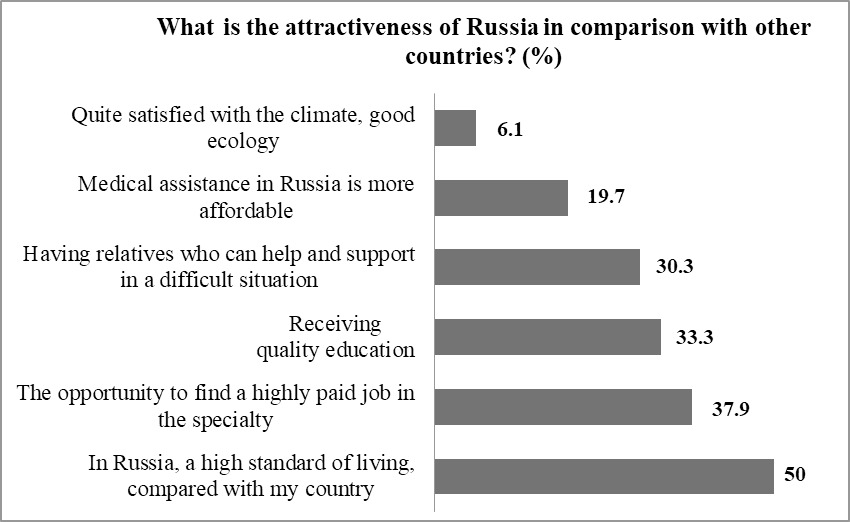
Upon arrival in Russia, more than half of the respondents faced problems. Of these, about 70% — with «lack of housing», more than 60% — with «lack of money», more than half experienced «registration difficulties,» and about 30% felt «prejudiced treatment by law enforcement agencies.» Every 10th «clashed with the local population».
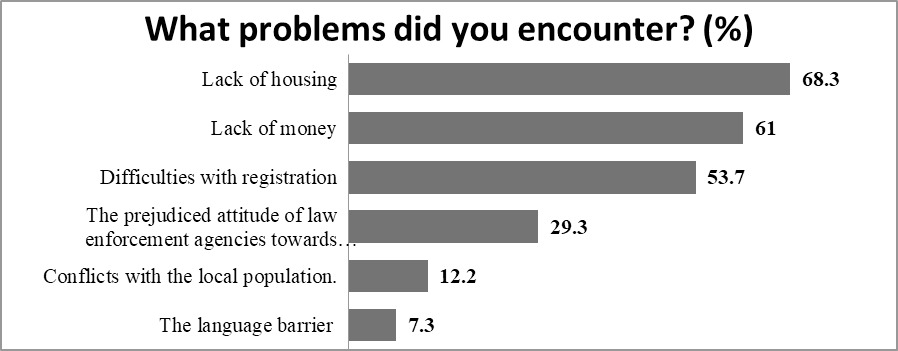
These data correlate with the data of the following diagram. Only a fifth of the respondents believe that the local population «rather positively than negatively» refers to them. The others do not share this opinion or could not answer.
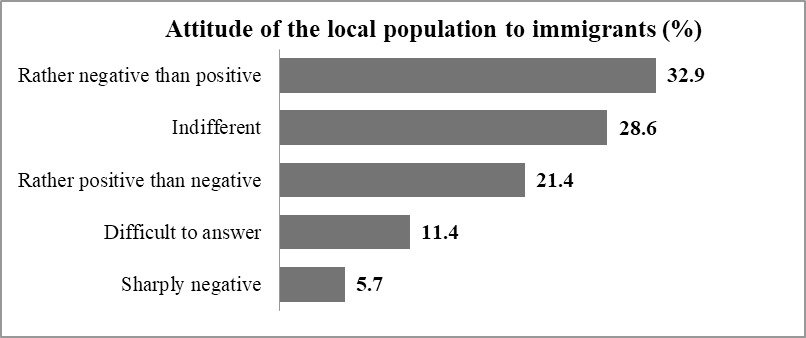
To the question: «What do you think, what would most of all the local population want from immigrants?» Half of the respondents noted the importance of «observing local norms and rules of behavior» and «knowledge of the Russian language». More than 40% of respondents — «compliance with Russian legislation». One out of three believes that local visitors are expected to have a benevolent attitude, conscientious fulfillment of their work duties or they want them to leave Russia as soon as possible. These respondents are aware of the importance of these indicators for the local population.
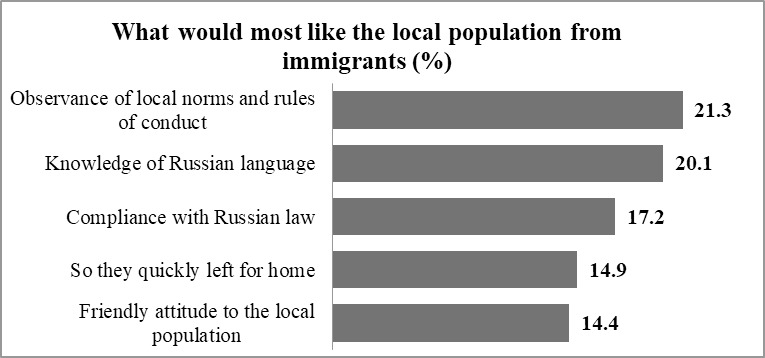
More than half a dozen of those surveyed in assessing the benefits that they believe immigrants from Russia bring to their country have stressed that the newcomers «carry out low-paid, unskilled jobs for which Russians do not undertake.» More than a third noted that they «supplement the state budget by buying patents for labor activity and paying the state fee». A slightly smaller number of respondents indicate that «young immigrants improve the demographic situation in the country, becoming Russian citizens and creating families among themselves and with representatives of the local population.»
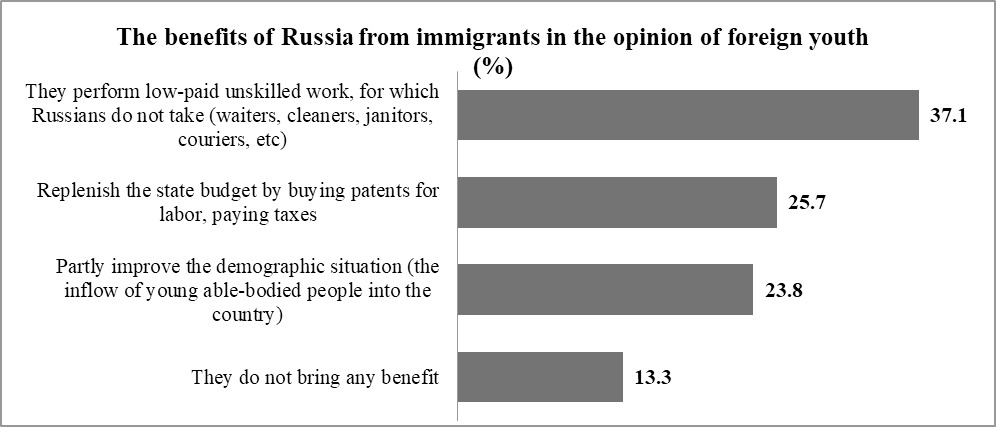
When determining the level and conditions of study in Moscow universities, it was found that it meets the expectations of the respondents, and only every 10th foreign student wants to return to the homeland after graduation.
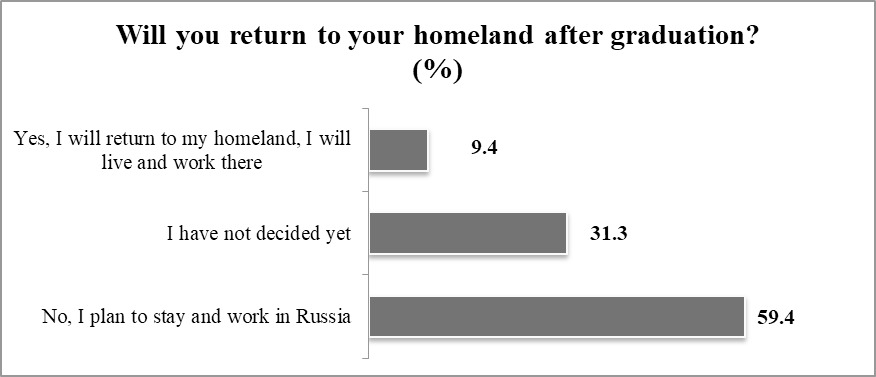
The majority (about 80%) of visitors had quite favorable relations with classmates, which is evidence of their successful social adaptation to the student body. However, every tenth feels lonely. Perhaps this is due to their psychological characteristics, which interfere with the processes of adaptation to any new environment.
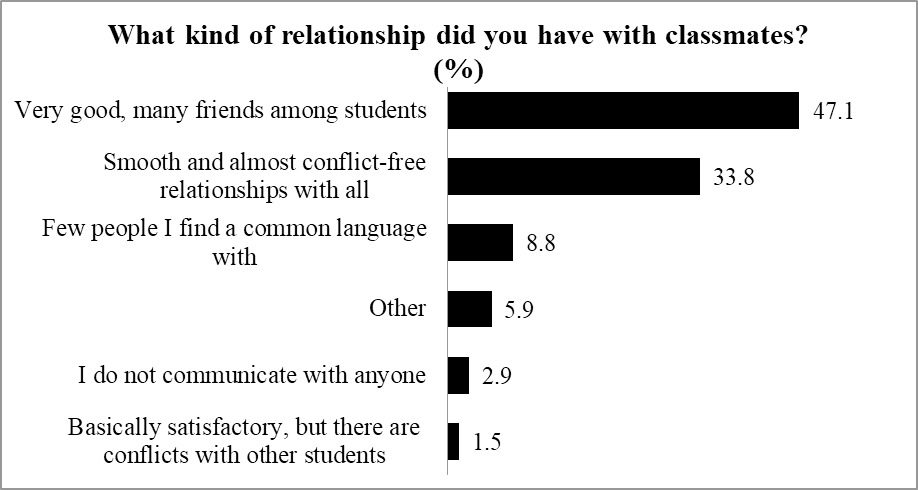
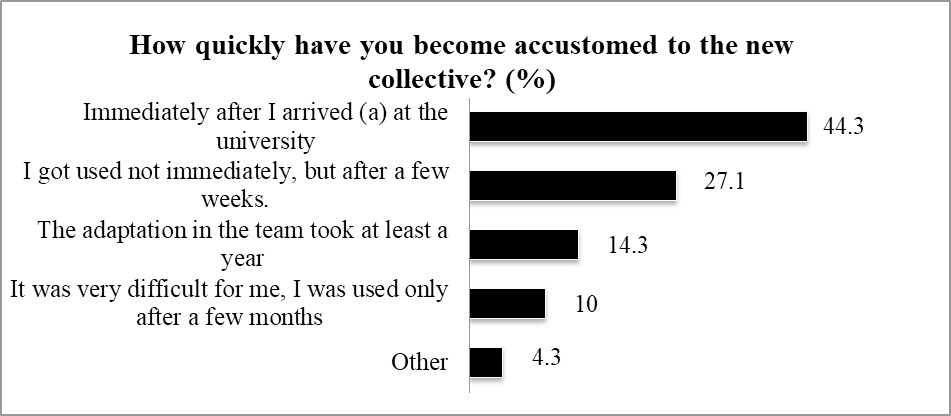
Most of the respondents (44.3%) quickly got used to the new collective; 27% took several weeks; every fourth — from a few months to a year. Still, we can note the high rate of adaptation in the new conditions of most visitors, if we take into account the economic difficulties they encounter upon arrival in Russia, especially since 3/4 of the students are in the middle category in terms of material support. They do not starve, but they can not afford everything. To improve their financial situation, half of the respondents earn extra money. The main types of sub-work: vocal creativity, management; work as a salesperson, an assistant at the firm, a doctor-trainee; in the hotel business, catering, etc.
In the course of theoretical research and analysis of empirical data, the necessary conditions for the successful adaptation of immigrant students to the educational environment of Moscow universities were determined.
They can be divided into two groups: subjective and objective.
Subjective include:
• high motivation of young immigrants to overcome the inevitable economic, social and socio-psychological difficulties that they face in a foreign country;
• readiness to join the culture, history and traditions of Russia, to become a part of this country, to observe its legislation, not to violate moral principles.
The objective are:
• The policy of the receiving immigrant state aimed at regulating migration flows;
• assistance to immigrants in obtaining registration documents in the «one-stop» mode;
• allocation of quotas for the training of foreign students in Russian universities;
• formation of a tolerant attitude towards newcomers.
Objective conditions include the purposeful organizational work of the university on the adaptation of foreign students to the educational environment, which includes:
• assistance in their social and domestic arrangement (providing the hostel with a training period);
• organization of elective classes to study the basics of Russian legislation, state structure, history and culture, and, if necessary, accelerated Russian language courses;
• Involvement of foreign students in extracurricular activities (the work of the Student Council, high schools, scientific activities, sports sections)
References
1. Becker I.L. Problems of adaptation of foreign students to the educational process of the Russian University / materials from magazine No. 4 (36) — 2015. URL:http://cyberleninka.ru/article/n/problemy-adaptatsii-inostrannyh-studentov-k-obrazovatelnomu-protsessu-rossiyskogo-vuza-na-primere-penzenskogo-gosudarstvennogo
2. The State Program of the Russian Federation «Development of Education» for 2013-2020-URL: http://window.edu.ru/resourse/823/76823
3. Smirnov A.A. Psychology of university adaptation: Textbook / AA Smirnov, NG Zhivaev. — Yaroslavl: YarSU, 2009. — 119s. — URL: http://www.lib.uniyar.ac.ru/edocs/iuni/20090520.pdf
Bakashvili G.D.
Simple
Bakashvili G.D., 2nd year student {Sociology}
Scientific adviser: Kyuregyan M.P., senior lecturer
State Educational Institution of Higher Education Moscow Region «University of Technology» Korolev, Russia
This report is about philosophy of life: Simple. Nowadays people always think and say that life is not easy. But in this article it says that our life is Simple. You need to live and do what you like and then everything will be fine.
Keywords: Simple, life, philosophy.
Hello. My name is Gigi. Just Gigi. And today I want to tell you about philosophy of my life. There are reports about politics, science, culture, economic but let’s talk about life. Imagine that we are sitting in the kitchen and speaking
Imagine? Let’s star
Simple. What does it mean?
It seems to us that Life is a big system where everything is not clear. We always think and say that life is not easy.
But stop fooling yourself, stop living with illusions, Life is Simple.
Our life consists of pixels, tiny dots that make up our life. Every action, thought, idea- they are the pixels, which make up our life. This is the main idea of my philosophy: SIMPLE.
Why am I telling you about this Right now? Because I Just want to do it and You are just listening to me.
Growing up we think that we need to be serious. Influenced by society and stereotypes sometimes we don’t commit those actions that actually we want to do. We always think about how we will be looked at, how we will be estimated.
Why can’t we do what we want, why can’t we say what we want. We Just want it.
Stop living in a cocoon. Stop living the life you live.
Who wants a cool car?
Which of you wants to go on a holiday?
That’s just what you want. But You’re just sitting here, wasting time.
Why don’t people achieve what they want. Why do they always want to blame anybody? Why do they think that others should everything do for them? Because they’re lazy,.
Just start with a clean sheet of paper. Look at the world as if you have just one day and that’s it. Everyday Wake up with the thought that today is the last day. And you’ll notice how simple and easy our life is. And most importantly this thought will change your world. Just what you need. It’s Just. Every culture, religion has the expression: we’ll live till Monday and we’ll see what happens.
Start
You will think that philosophy: Simply — it is invented by me. But I will please you. No. This philosophy is followed by famous people from all over the world.
To word one of prominent people of our time. Nick Vujicic. He also follows this philosophy. Willpower, indomitable spirit, faith and optimism helped nick Vujicic to get a higher education, to become a famous preacher, an author of popular books, a happy father and a millionaire. And most importantly he understood it’s very simple, moreover with his situation.
Speaking about me.
Why have I come to the fact that everything is Simple?
Once i sat down in the kitchen, turned on the music and began thinking. Why don’t i have what I want. And I want a lot. My own Apartment, my own car, my unforgettable travels. Why don’t I have it. And thinking about it I realized it was all in my head. I am always putting it off.
Fo my friends I’m a good friend. For my mother I am a good son. But for myself I’m the enemy. I set aside everything. I wanted to know a lot, to understand many things, to read, but I was too lazy One day, and it wasn’t Monday. I decided to change my life.
Lets take last month. I Read 10 books, wrote a cool book that has found approval among many people. Moreover Two clothing brands have been created. 15,000 thousand rubles have been earned by me, not counting income from my brands. And realize my life has filled with a real meaning.
Do You know why? I just wanted it. My classmates used to say, Gigi, why are you doing this? And I answered, I want it. I just wanted it.
I am able not to sleep at night and do what I love and want to do.
What do I want to tell you?
You probably think what nonsense he’s talking about. You’ll probably be right. But It’s so SIMPLE that you are afraid of it
Stop being afraid, start doing what you want.
As the little Prince said, Adults are very strange people.
And I wish you wouldn’t strange…
Bejan V.I.
Le phénomène Tanguy
Bejan V.I., Étudiante de 1ère année {Psychologie}
Directrice scientifique: Kogteva E.V., maître de conférences
Etablissement d’Etat d’Enseignement superieur
«Université des Technologies»
Korolev, Russie
Dans le film d’Etienne Chatiliez, le jeune « Tanguy» se complaît jusqu’à un âge avancé dans l’appartement cossu de ses parents. La réalité des jeunes hébergés chez leurs parents est un phénomène massif, mais hélas souvent bien plus sombre que dans le film.
Mots-clés: Phénomène, logement, responsabilité, solitude, adulescence.
Tanguy n’est plus une fiction, c’est un phénomène. L’histoire de l’homme de vingt-huit ans contée dans le film d’Étienne Chatiliez, en 2001, est devenue celle de millions de jeunes, 56,8% des garçons et 43,2% des filles. Ils sont 4,5 millions de majeurs à vivre chez leurs parents ou grands-parents, dont 1,3 million dépassent l’âge de vingt-cinq ans, selon le rapport publié par la Fondation Abbé-Pierre. La Fondation n’hésite pas à parler de «pénalisation des jeunes par la flambée des prix sur les marchés immobiliers» [3].
Parmi les jeunes hébergés, 18% sont par exemple au chômage. Et même lorsqu’ils occupent un emploi, leurs ressources ne permettent pas toujours d’accéder à un logement indépendant.
Les jeunes déjà sortis du système scolaire sont plus nombreux à vivre exclusivement chez leurs parents (65%) que les étudiants (50%). Des chiffres qui soulignent les difficultés des jeunes se lançant sur le marché de l’emploi: une majorité d’entre eux ne peut pas quitter le logement familial, faute d’avoir trouvé un emploi, ou a sans doute une situation professionnelle trop précaire pour accéder à un logement autonome. Ils ont des ressources limitées qui ne leur permettent pas de partir ou économisent pour préparer leur autonomie résidentielle [1].
Et parmi les jeunes qui disposent de leur propre logement (43%), l’autonomie financière n’est pas encore réelle pour beaucoup d’entre eux, car 29% d’entre eux se font aider par leurs parents pour payer leur loyer. Par ailleurs 2 jeunes sur 10 qui ont un logement autonome, continuent quand même à vivre en partie chez leurs parents pour trouver un surcroît de confort qu’ils n’ont pas chez eux.
Les «Tanguy» ces individus qui résident encore chez leurs parents après la fin de leurs études, sont frappés de plein fouet par la crise. En France, cette situation concernait 11,6% des 25 à 34 ans selon les dernières données d’Eurostat disponibles.
Selon l’étude de l’Insee, seulement 1 jeune sur 10 étudiants ou en emploi habitant chez ses parents ressent un sentiment de privation élevé et 7 jeunes sur 10 dans ces cas se déclarent satisfaits de leurs conditions de vie. « Résider avec ses parents n’est pas globalement vu comme une contrainte, car cela permet de bénéficier d’aides en nature, comme l’alimentation, les équipements, la voiture…», Et 88% des jeunes cohabitant avec leurs parents déclarent aussi bien s’entendre avec eux.
Ils retardent le départ du nid familial, parce qu’il s’y plaisent tout simplement. «Quand on est petit on a déjà le droit à des bouts de monde. Un adolescent peut en partie avoir le sentiment que sa chambre est chez lui», indique le sociologue de la famille François de Singly [2].
Certes les enfants restent dépendants mais ils ont acquis le sentiment d’avoir une certaine autonomie. Bref, un monde à part favorisé par une omniprésence des biens de consommation. Mais surtout une plus grande intimité liée à l’évolution des mœurs qui permet aux jeunes de vivre une seconde vie dans leur chambre. «Ils ne sont pas forcément pressés de partir, parce qu’au fond si l’ambiance familiale est bonne elle n’est pas traumatisante», justifie le sociologue, avant de préciser que pour avoir leur intimité, les générations passées n’avaient pas d’autre choix que de partir au plus vite.
L’origine de ce phénomène des Tanguy est concentré de diverses problématiques socioéconomiques et sociodémographiques prégnantes: crise du logement, plus grande difficulté des jeunes à s’insérer, financement des études, etc.
Mais avant tout, on constate que les jeunes ont une certaine peur de l’indépendance. En effet depuis quelques années, ils sont trop bien encadrés, que ce soit au sein de la famille ou dans le cadre scolaire. Arrivé à l’âge majeur, indépendance rime avec responsabilités. Ils ont peur d’assumer certaines responsabilités comme tenir un budget, ou simplement faire les courses, faire à manger, etc. L’enfant Tanguy a également peur de la solitude au sens propre du terme. En restant chez ses parents, il sait qu’il n’aura pas à affronter cette peur car il sait que l’amour de ses parents est comme inconditionnelle. Cette peur est aussi présente au niveau des responsabilités; c’est d’une certaine manière la peur de grandir qui l’empêche d’avancer et qui le conforte ainsi dans sa peur. C’est un cercle vicieux. Ces raisons expliquent en grande partie pourquoi l’adulte enfantin c’est-à-dire l’adulescent préfère rester chez ses parents au lieu de devenir indépendant et autonome [2].
Selon le psychanalyste Tony Anatrella « l’adulescence est le prolongement de l’adolescence en dépit de l’entrée dans l’âge adulte». Ainsi, ces adultes sont des jeunes gens qui, en refusant de grandir, conservent les avantages des trois «états»: enfant, adolescent, adulte. Ils peuvent donc s’adapter à toute situation: retomber en enfance, jouer à des jeux vidéos ou assumer des responsabilités au travail [2].
Ce phénomène se fait ressentir dans d’autres domaines: de social au début, il est devenu économique car l’adulescence représente un marché lucratif. D’où la création de produits s’inspirant de l’enfance, utilisant des formes et des couleurs ludiques. Par exemple, des automobiles telles que Twingo, Smart, New Beetle rappellent des jouets; l’adulescent ose la couleur dans l’habillement et se déplace plus souvent en rollers ou en trottinette. Il est également gros consommateur de toutes les nouvelles technologies: il aime les jeux vidéos ou en réseau et les sites Internet dédiés à ses chanteurs préférés et aux dessins animés de son enfance. Il fréquente régulièrement les raves parties et les parcs d’attractions. Enfin, il prend beaucoup plus soin de lui. Comme l’affirme l’article paru en juin 2002 dans le Monde, «les interventions esthétiques chez les hommes jeunes ont augmenté de 400% en quinze ans».
Mais le phénomène Tanguy n’existe pas qu’en France. Ces jeunes qui n’arrivent toujours pas à quitter leur cocon familial, il en existe de partout. On les appelle juste différemment. Aux États-Unis, on les appelle les Boomerangers, en référence à la génération boomerang, partie du foyer pour y revenir, poussée par la crise. Au Japon, on les appelle les Parasaito Shinguru ou célibataires parasites. Ce qui a le mérite d’être clair quant au jugement que la société porte sur le phénomène… En Allemagne, on parle de Nesthoker. Littéralement pilleur de nids, le nom donné aux oiseaux qui naissent nus et aveugles.
La réalité paru le dernier temps contraste avec l’image du Tanguy: ce sont les parents qui dépendent de leurs enfants. En milieu populaire par exemple, certains Tanguy qui habitent encore à 35 ans chez leurs parents, tiennent le rôle de maîtresse de maison, ils s’occupent de leurs parents qui sont au chômage, ou maladies.
Bibliographie
1. https://www.humanite.fr/tanguy-nest-pas-une-fiction-cest-un-phenomene-591866
2. http://psychologieclinique.over-blog.com/
3. La face cachée des «Tanguy». Les jeunes en hébergement contraint chez leurs parents http://www.fondation-abbe-pierre.fr/documents/pdf/la_face_cachee_des_tanguy.pdf
Volnykh K.S.
Democracy as the power of the minority, or the liberalization of consciousness
Volnykh K.S., 1st year student {Quality management}
Scientific adviser: Atrokhin A.M., PhD {Philology}, associate professor
State Budgetary Higher Educational Institution Moscow Region
«University of Technology»
Korolev, Russia
The article describes the problem of creating and exaggerating problematic issues that are unnecessary for society globally. Without the use of adequate criticism to their essence, prior to the question. The problem is considered on the example of the real situation in the country in which the problem looks the most contrast. The urgency of the problem lies in the excessive desire of people to go against the system and show themselves without thinking about the consequences. To break down what was built and conceived by people with strategic thinking, or just historically it turned out, that in turn requires much more time and effort.
Keywords: business style, degradation of the population.
Everyone knows that the Englishmen are great lovers of classical style. Due to the high position of England on the world stage, as well as the immeasurable arrogance of its inhabitants, every conscious Englishman is inappropriate to dress sloppy. But time goes on, in society there are more and more disagreements about the necessary and necessary, among the correct and habitual. Of course in the country with a craving for snobbery and meticulous observance of all traditions at the subconscious level, in most cases, innovations does not apply. But still it happens that traditions so important for the British are subjected to really serious pressure, not just ridicule.
In December 2015, Nikola Tropez, an employee of «PricewaterhouseCoopers» international in London, was fired due to non-compliance with the dress code. She came to work in ballet flats and on the requirements of the managing, to buy shoes on the heel, refused. Tropez called the situation discriminating against women, as men do not make such demands. She filed the petition «don’t allow companies to require women wearing high heels at work» and has collected more than 124 thousand signatures in his support, that means an automatic consideration in the British Parliament (in accordance with local laws) [1].
In the above-described problem, there are several dilemmas with different depth of philosophical thought. At the same time, the less this depth, the more primitive life and thinking of those people, for which the question raised is a problem. This is due to the degradation of the consciousness population, except in very rare cases. And all this is easy to explain.
The first about what Nikola Tropez was indignant, there was a exclamation comparable to kindergarten — and why to men don’t show the same requirements, as well as to me? This can immediately be called sexism, discrimination, and seriously affect the situation, that and was done, so as it was adopted explore in Parliament, and the company in which she worked, had to change its policy in this matter. But the Trails did not look at the fact that both men and women have equal requirements for appearance, they must be respected by all equally and on equal terms. But differences in the requirements (which are the norm), this is the tradition, which incidentally, was not the one-time decree of one of the rulers and in part due to differences in physiology, as in type of clothing of different genders influenced the psychophysiology of a person. Accordingly, the girl just wanted to stand out, or become famous, given the status of the organization in which she worked, she definitely has ambitions.
If the in life of the Englishmen that it will on public display, they will play it completely honest, and to refer to it in a convenient case. Therefore, despite the fact that the British, unlike the Italians, do not think about some special compatibility of things, or unlike the Germans do not observe absolute rigor, they are much more important than others to be in a suit and respect themselves for it. The fact is that if Nikola Tropez had a good reason, such as back problems, she would not have been fired, and would not have asked for a medical report, but it is absolutely asked to change the ballet flats on the classic women’s shoes in men’s style. The employer would not have to use his legal right to require such employee high heel, of course the Englishmen, in some sense, the heinous, but not so strongly, because to infringe on the needs of sick people is far more dangerous to their reputation than to infringe on antisexists. Despite the fact that in fact everything is the opposite.
And so, most likely our heroine got what they wanted, no matter what she saw or did not see the issue as a whole. The main thing is that 124 thousand people who supported the petition Nikola Tropez did not see, and did not even try to understand this issue. The fact is that it is unacceptable to change the business style of the country at the level of legislation, to please the ambitions of short-sighted individuals. Moreover, only thanks to the unspoken tradition of the Englishmen about tolerance, this issue decided not to reject the consideration of the Parliament, in any other country it would not be taken seriously. But if the law is changed, many Englishmen will operate with claims of discrimination, placing them above the traditions of centuries. The people of Britain themselves speak about the importance of observing traditions and about the threat of a split in society in case of their non-compliance. Therefore, the described situation is a vivid example of what should not be done, the classic style is called classic, because that its common features are always unchanged.
In this example, we see the pressure of public opinion on the country’s policy. But the pressure is not all society, but only part of it. After all, London is home to almost nine million people and not 124 thousand (that’s 72 times less). Accordingly, a minority can ruin the lives of everyone else, including those who did not even know about any public resentment. Such examples are not small, the most striking example is the legalization of same-sex marriage in the United States. Apart from those who did not sign any petitions (this is by default a lot of people), for and against was roughly equally split. Accordingly, it was the minority that decided the fate of society. The result can lead to a decrease in the demographic situation, as well as inevitably lead to the degradation of society, to the complete loss of sacred meanings and, as a result, to a decrease in intellectual abilities, all under the influence of such legislation.
The conclusion, the thoughtlessness levity of many people in society is forgivable, and in no to lend themselves to case should the public go on about, for the government this is unacceptable. But the in government itself clearly has short-sighted and at the same time very active people who are a threat to the country. Enforcement obviously harmful laws, confirms the availability of such people. Consequently, all the countries of the world pay little attention take a deep strategic analysis of the consequences of the adoption of any decisions, as well as finding the right balance of values of the population (taking into account the non-voting part) and economic needs.
References
1. News Internet edition «РИА НОВОСТИ»: https://ria.ru/world/20160513/1432571234.html
2. Document «An Economic Assessment of Same-Sex Marriage Laws»: https://www.sfu.ca/~allen/samesexmarriage.pdf
3. News Internet edition «INLIBERTY»: http://www.inliberty.ru/library/675-Sudba-nastoyashchego-v-shyrukah-nastoyashchego
4. Основы психофизиологии: textbook / отв. ред. Ю. И. Александров. — М.: ИНФРА-М. — 340 с. 1997.
Gaisina D.R., Ivanov A.I., Gaisin А. I.
Improving the construction of a stationary booms with variable buoyancy
Gaisina D.R., 2nd year master-student {Oil and gas business}
Scientific adviser: Ivanov A.I., PhD {Technical Sciences}, associate professor
Ufa State Petroleum Technological University
Gaisin А. I., Lead Engineer of the production preparation
department of LLC «Order of Lenin Trust «Nefteprovodmontazh»
Ufa, Russia
The article considers the main types of booms, their advantages and disadvantages are revealed. As a result of the analysis, an improved design of a boom of a variable buoyancy is proposed. In cases where the boom is blocked by a pipeline has a strong hydrodynamic effect and bends in the horizontal plane. To exclude this factor, the strength and rigidity conditions are calculated, according to which the maximum permissible distances between the braces are selected, as well as the required number of them.
Keywords: Stationary booms, oil, variable buoyancy, freezing.
The leakage of oil or oil products in the event of a breach of the tightness of the pipeline at the crossing of water barriers represents a huge environmental hazard, causing great material damage to the oil transportation company in the form of costs for localizing spills, eliminating their consequences, fines, etc. In this regard, it is necessary to develop and implement preventive measures for the containment of spills, as well as measures to respond as quickly as possible to the fact of such a leak. This task is especially important in the winter, during the freeze-up period, when the presence of ice and snow on the surface of the reservoir often makes it impossible for a timely visual detection of the leakage, as well as the use of any serially produced boom structures for spill containment [1, 2].
The booms used today have shortcomings in the form of difficulties in operation, separate technologically executed sections, and insufficient reliability [1].
To solve the problem, it is proposed to develop a system of all-season stationary booms of variable buoyancy.
The authors consider in detail the advantages and disadvantages of existing boom systems, identify the main problems of the application of certain systems, and proposed a new improved system of stationary boom.
The basis of the system design is a polyethylene pipe, laid along the steel cable from shore to shore, downstream of the transition.
The two ends of the pipe are not hermetically sealed communicate with the water mass of the river. On the pipe are welded mounting loops («ears») for passing the steel cable. The pipeline in its lower part is equipped with one row of elastic elements that perform the function of retaining spilled oil.
The strength and rigidity conditions were calculated, according to which the maximum permissible distances between the braces are selected, and the required number of them.
If necessary, in the absence of navigation or during the freeze-up period, the system may be in working order continuously.
The specific location of the system is determined individually, depending on the speed of the current, the width and depth of the river, the relief of the coastline.
The simplicity of the system ensures its high reliability in all weather conditions at any time of the year, and the speed of its bringing into working position is the reduction of all types of damage from oil spills. The low cost of the components and materials of the system can ensure its widespread introduction into production.
References
1. Pipeline transportation of oil and gas / R.A. Aliev, V.D. Belousov, A.G. Nemudrov and others. — M.: Nedra, 1988. — 368 p.
2. Pipeline transportation of oil. G.G. Vasiliev, G.E. Korobkov, A.A. Korshak and others. Ed. CM. Weinstock: Proc. for high schools: 2 t. — M.: LLC Nedra-Business Center, 2002.
Gasanova A.N.
L’Organisation mondiale du commerce et l’adhesion de la Russie
Gasanova A.N., Étudiante de 2ème année {Douane}
Directrice scientifique: Kogteva E.V., maître de conférences
Etablissement d’Etat d’Enseignement superieur
«Université des Technologies»
Korolev, Russie
Dans cet article on examine le processus de création de l’organisation Mondiale du commerce (OMC), à la suite de la transformation de l’accord Général sur les tarifs douaniers et le commerce (GATT), ses étapes principales et leur impact sur les règles et les principes de l’OMC et la place de la Russie dans l’OMC.
Mots-clés: Commerce, accord, libre-échanges, mondialisation, adhésion.
Après la fin de la Seconde guerre mondiale, la volonté de développer les échanges commerciaux et de les libéraliser pour éviter un retour au protectionnisme de l’avant-guerre a conduit à la conclusion de l’Accord général sur les tarifs douaniers et le commerce (GATT). Au fil de cycles successifs de négociations, le GATT a lié un nombre croissant de pays et couvert de plus en plus de domaines. En 1995, suite aux accords de Marrakech, il s’est inséré dans une nouvelle structure permanente, l’Organisation mondiale du commerce (OMC).
C’est la seule organisation internationale ayant pour mission de réglementer le commerce entre les pays. Son action se fonde sur une soixantaine d’accords internationaux. Son objectif central est d’ouvrir au libre-échange tous les secteurs d’activités humaines, y compris les services, dans tous les pays du monde. Pour le commerce des marchandises, l’OMC surveille les tentatives de dumping, de subvention, ou les aspects sanitaires étant indépendante de l’ONU.
C’est une Organisation internationale qui s’occupe des règles régissant le commerce international, dans le but de favoriser la liberté et la transparence dans les échanges. Les gouvernements membres négocient des accords commerciaux et règlent leurs différends commerciaux à l’OMC.
Les principaux objectifs de l’OMC consistent à d’assurer la liberté, l’équité des échanges en :
— administrant les accords de l’OMC;
— réglant les différends commerciaux par le biais d’un Organe de règlement des différends;
— et servant de cadre aux négociations commerciales.
Les pays prennent les décisions au sein de quelques 65 conseils, comités et groupes de travail, composés de représentants de tous les membres.
L’organe suprême est la Conférence ministérielle qui, selon les statuts, doit se réunir au moins tous les deux ans. Le Secrétariat de l’OMC a son siège à Genève. Il est composé d’environ 650 fonctionnaires permanents sous l’autorité d’un Directeur Général, Roberto Azevêdo actuellement.
Naturellement, la mondialisation est la cause de besoins dans les institutions internationales, qui contribuent au développement de libre-échange, qui, à son tour, est l’une des principales forces motrices de la mondialisation.
Depuis sa création en 1995, l’Organisation mondiale du commerce est devenue un élément essentiel de la gouvernance économique mondiale. Aujourd’hui, 98% des échanges commerciaux se font conformément aux règles de l’OMC, seule organisation internationale chargée de réglementer le commerce entre les pays.
Selon l’accord, «Tout Etat ou territoire douanier jouissant d’une entière autonomie dans la conduite de sa politique commerciale peut accéder à l’OMC à des conditions à convenir entre lui et les membres de l’OMC». Le processus complexe d’accession à l’OMC prend la forme de négociations bilatérales et multilaterals [2].
Apres dix-huit ans de négociations la Russie est devenu le 156ième membre de l’ OMC en 2012. Cette adhésion a donné des devoirs comme des droits. La Russie bénéficie des privilèges de régler des conflits commerciaux. Dans le cadre de l’OMC de nouvelles possibilités se sont ouvertes aux exportateurs russes sur le marché mondial. Pour la Russie les risques de cette adhésion sont la baisse des taxes d’importation, la limitation des formes de soutien de l’Etat à certains secteurs et par conséquent la hausse de la compétitivité des produits étrangers [4].
De plus, les barrières douanières ont disparu sur 700 catégories de produits, ce qui a fait baisser les taxes à l’importation de 10 à 7% pour les produits russes.
Normalement, l’adhésion à l’OMC signifie plus de sécurité juridique pour les investissements étrangers (essentiels pour la modernisation du secteur énergétique notamment) et l’élaboration d’un contexte plus favorable aux affaires en général et donc à l’économie [1].
Après l’adhésion de la Russie à l’OMC, la société Strategy Partners Group avait réalisé un sondage auprès de deux mille entrepreneurs russes dont le chiffre d’affaires est supérieur à 100 millions de dollars. À l’époque, plus de la moitié d’entre eux attendaient des changements positifs pour l’économie russe. Désormais, plus de la moitié pensent que l’adhésion de la Russie à l’OMC n’a eu aucun impact sur l’économie et 32% sont persuadé qu’elle a été negative [3].
Le rapport de la fondation souligne également que les restrictions appliquées aux produits russes sur les marchés mondiaux n’ont pas été automatiquement levées — sur les 94 mesures antidumping appliquées aux produits exportés de Russie, seulement 4 ont été annulées. L’abrogation du reste des mesures devra faire l’objet de négociations dans le cadre de l’OMC. Tandis que la Russie a levé les restrictions sur les produits agricoles dès le premier jour de son adhésion à l’organisation.
Le grand espoir qui existait au moment de l’adhésion de la Russie à l’Organisation mondiale du commerce, ne s’est pas réalisé. Actuellement, notre participation ne fait que du mal et de plus, on fait face à une véritable guerre commerciale où il n’y a pas de concurrence honnête. Sous la pression des sanctions occidentales actuelles, la Russie a dû prendre des mesures de riposte et la situation de la Russie à l’OMC restera vulnerable [3].
Bibliographie
1. Vercueil Julien, « La Russie et l’OMC. Enjeux d’une adhésion annoncée», Le Courrier des pays de l’Est, 2003/1 (n° 1031), p. 58—65. URL: https://www.cairn.info/revue-le-courrier-des-pays-de-l-est-2003-1-page-58.htm
2. https://www.wto.org/indexfr.htm
3. https://www.egaliteetreconciliation.fr/La-Russie-a-l-OMC-une-adhesion-inutile-18881.html
4.http://www.ifri.org/sites/default/files/atoms/files/ifrifeanrussiawtofrafev2012.pdf
Elkin S.V.
Analysis of malware and domain name system traffic
Elkin S.V., 4th year student {Banking}
Scientific adviser: Romanov P.S., Doctor of Pedagogical Sciences, Professor
State Budgetary Higher Educational Institution Moscow Region
«University of Technology»
Korolev, Russia
As the title implies the article describes Domain Name System (DNS) and Analysis of malware program, channels DNS, traffic DNS, payload distribution channels. It should be noted about this problem is quite relevant to date. Many people use the computer and the Internet do not suspect about malicious programs. However, malicious programs are becoming more dangerous every day. Analysis of malicious programs botnet can reduce the number of unsafe programs on the Internet. Every day it is more difficult for cybercriminals to harm computer users.
Keywords: DNS, DNS server, malware, Zeus botnet, DDoS, cyber attacks, Zeus botnet, analysis of malware program, payload distribution channels.
Malicious domains host command and control servers are usually used to instruct infected machines. The main task is to perpetuate malicious actvities. They encompass sending spam, stealing credentials, launching denial of service attacks.
Both static and dynamic analysis of malware as well as monitoring Domain Name System (DNS) traffic provide valuable insight into such malicious activities and help security experts detect and protect against many cyber attacks.
Advanced crime ware toolkits were responsible for many recent cyber attacks. In order to understand the inner workings of such toolkits, present a detailed reverse engineering analysis of the Zeus crime ware toolkit to unveil its underlying architecture and enable its mitigation. Analysis allows us to provide a breakdown for the structure of the Zeus botnet network messages [3].
This framework can be used to extract valuable cyber intelligence from the analyzed malware. The obtained intelligence helps to reveal important insight into different cyber attacks and uncovers abused domains as well as malicious infrastructure networks. Based on this framework, programmers develop a severity ranking system for domain names. The system leverages the interaction between domain names and malware samples to extract indicators for malicious behaviors or abuse actions. The system utilizes these behavioral features on a daily basis to produce severity or abuse scores for domain names. Since system assigns maliciousness scores that describe the level of abuse for each analyzed domain name, it can be considered as a complementary component to existing (binary) reputation systems, which produce long lists with no priorities.

In this thesis, we study the problem of Domain Name System abuse by utilizing malware analysis and monitoring the DNS traffic. The proposed solutions can be employed to investigate different cyber crime attacks and provide insightful intelligence, recommendations, and malicious ness indicators. As depicted in Figure 1, the analysis of Domain Name System abuse starts by building a frame work that extract insights into malicious networks from the dynamic malware analysis reports. This framework can help investigators to collect preliminary information about different cyber attack incidents and rectify them in shaping the investigation process [1].
A typical investigation starts by collecting simple statistics such as active malware families and most abused Internet Service Providers (ISPs). In addition, researcher may be interested in discovering the structure of the suspicious networks, which can be achieved by frame work by applying network analysis techniques. Furthermore, framework provides geolocation information about compromised machines in order to gain deeper insight into targeted attacks.
Main objective is to generate timely, relevant and actionable cyber threat intelligence.
This can be achieved by:
• Understanding most prominent threats to extend the knowledge about malware inner workings, behaviors and enabling techniques and technologies.
• Deriving cyber threat intelligence from malware analysis to reveal more insights about different cyber attacks.
• Analyzing the severity of domain names and name servers to overcome problems associated with traditional black listing approaches, one must provide more information about each blacklisted domain in order to facilitate and prioritize the investigation process.
• Investigating the malicious use of DNS to transport payload.
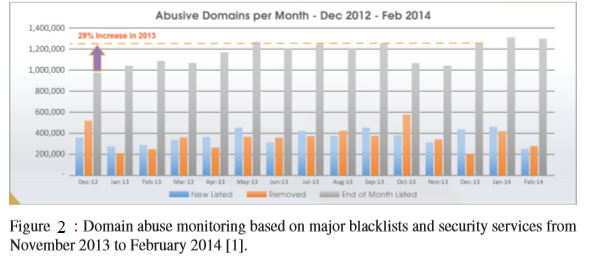
Domain Name System abuse incidents are increasing dramatically as reported by Architelos (see Figure 2).
Security professionals adopt domain name blacklisting, which is regarded as one of the basic defense lines against DNS abuses. However, domain black lists are to increase progressively limited and ineffective in fighting the ever increasing number of malicious domain names appearing every day. To overcome this problem, blacklisting approaches must provide more information about each black listed domain in order to facilitate and prioritize the investigation process. Blacklisting can be extended to include detailed maliciousness indicators to focus on specific types of attacks while dealing with cyber attacks. To a chive this in article, is adopted apply a statistical reputation system to generate severity scores for domain names.
Name servers play an important role in the DNS infrastructure to provide the necessary information about domain names. In recent times, authoritative name servers have been abused to amplify DDoS attacks toward different victims Moreover, cyber criminals host their malicious domains on bulletproof name servers equipped with various techniques, which impede takedown operations. In fact, the abuse of name servers has increased by advanced techniques requiring the control over name servers. To tackle this problem, reputation systems can be built around name servers to fight the root cause of malicious domains and minimize their hosting power. On the other hand, name servers have been abused to distribute malicious payload to compromised machines.
One of the basic defense lines against cyber attacks is analyzing malware binary samples statically and/or dynamically to understand their behavior and thence develop detection mechanisms. However, the tremendous number of malware variants for the same malware family is severely affecting the utilization of the extracted information from the analysis [1].
For example, Mcafee reported more than 100,000 new malware samples every day in the year of 2012. Since the number of malware samples is rapidly growing, the dynamic analysis reports produce huge amounts of valuable information that need to be utilized effectively for further analysis [1].
To avoid being detected by various deployed detection systems, bots are designed in a specific way that enables them to change their propagation mechanisms over time. For instance, an infected bot may apply scanning to all possible ranges of IP space for computers running exploitable services. These exploitable services allow the previous infected hosts to inject a small amount of shellcode into the victim machine. Unlike worms, botnets are difficult to be class I field on the mere basis of their scanning techniques. Botnet shared opting such behaviors, and the existence of a human controller (bot master) allows them to cause more targeted attacks while maintaining a high level of stealth. With the development of more sophisticated protection and detection techniques, the method of botnet attacks is now more similar to that of a Trojan horse. Trojan strike victims into installing malware under the false belief that the malware is useful and beneficial soft ware. Similarly, bot infection spreads by transmitting binaries as email attachments. Once received, the naive user may open malware executables and thus become infected. These infection scenarios are comparatively less alarming, as the require some action on the part of a user for the completion of the infection cycle. Another effective infection technique, 13 known as web drive-by downloads, involves the user visiting a web site that can exploit targeted web browsers and thus infect the user’s system. In addition, P2P file sharing technologies are successfully exploited by bot masters to distribute malware binaries [2].
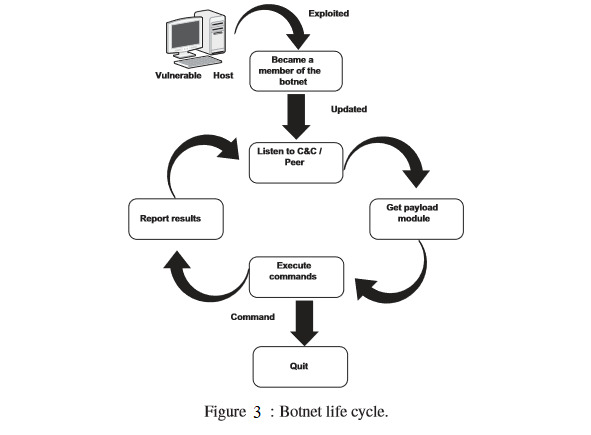
Botnet life cycle (see Figure 3).
The DNS protocol is designed to play as a translation service for the Internet infrastructure. The protocol receives a query for a specific Resource Record (RR), which describes the characteristics of a domain, and then responds with the corresponding answer based on a zone file. A zone file defines the services running under a particular domain. A domain name usually has multiplere source records dedicated for different purposes. These records consist of five main components: name, class, type, time-to-live (TTL), and data.
The resource record name is a Fully Qualified Domain Name (FQDN) that consists of several labels. The right-most label is the top-level domain, and each label represent sa level with in the DNS hierarchy. The label that comes after the top-level domain represents the second level domain, unless it is used as a sub-zone of a top-level domain, e.g., co.uk. Any label that comes after the second-level domain is considered as a sub-domain of the second-level domain. These sub-domains are defined and mapped to the corresponding resource record in the zone file. In some cases, a wildcard can be used to return the same resource record for any sub-domain. A sub-domain can be set up to have its own zone file with a dedicated name server. In this case, the name server of the second-level domain delegates queries to the name server of the sub-domain [2].
In this, shed light on the abuse of the DNS protocol by malware for distributing attack payloads. Examined a system to characterize and detect the payload distribution channels within passive DNS traffic. System observes the DNS zone activities of achannel by gathering access counts of each resource record type, and determines payload distribution channels. Found that most malware instances with DNS-based payload distribution use a resilient pattern to retrieve their attack payloads, ostensibly to blend in with regular network traffic. System is also able to detect payload distribution channels regardless of their syntax format. The evaluation of malware dynamic analysis reports demonstrated that our method can determine payload distribution channel patterns for different malware families [3].
References
1. Liu C., Albitz P. DNS and BIND, O’Reilly Media, 3d edition. — 1998. — September. — 502 p.
2. BIND. Internet Software Consortium. — 2018. — [Электронный ресурс] Режим доступа: https://www.isc.org/downloads/bind/.
3. Олифер В., Олифер Н. Компьютерные сети. Принципы, технологии, протоколы. — Учебник для вузов.– 4 изд. — СПб.: Питер, 2010. — 916 с.
Ladonicheva M.L., Puzyreva K.S.
Comparison of crypto-currency algorithms
Ladonicheva M.L., 2nd year student {Applied information science}
Puzyreva K.S., 2nd year student {Applied information science}
Scientific adviser: Atrokhin A.M., PhD {Philology}, Associate Professor
State Budgetary Higher Educational Institution Moscow Region
«University of Technology»
Korolev, Russia
Crypto-currency is virtual money that become very popular in the course of last few years. There are a lot of different crypto-currencies so the comparison of them seems very actual problem. In this article there are comparison of the most popular crypto-currencies and examination of theirs advantages and disadvantages.
Keywords: crypto-currency, virtual money, blockchain.
Today it is difficult to find a person who would not have heard about the crypto currency. But many still do not fully understand what it is all about and why.
What is a crypto currency?
Crypto currency is virtual money. Their history does not last for 10 years, but economists speak of them as a currency of a new generation. Already, Crypto-currency on the Internet is a worthy competitor of state currencies, and in the future can completely supersede them from the sphere of electronic transactions.
Why do I need a crypto currency?
Bitcoins and other coins are needed to make purchases, accumulation.
Although this is virtual money, they can pay for purchases on the Internet, exchange them for dollars, euros or sell on the exchange
For today there are more than 250 types of digital currencies, but not all of them are popular and in demand
History of appearance
The creator of the first crypto currency is Satoshi Nakamoto. Bitcoin 0.1 was released on January 9, 2009.
The emergence of bitcoin was a continuation of the development of the concept of blockade. The technology of blockade is a chain of information blocks built according to certain rules and in strict sequence, which can not be changed in any way. The entire bitcoin system is a continuous sequence of blocks, which reflect information about all transactions. In simple terms, the block system is the archive of the entire system, in which it is possible to track the turnover of each individual financial unit.
It is the technology of blockade that guarantees that counterfeit bitcoin is impossible in principle. The code for each coin is unique and easily tracked in the database, so an attempt at fraud will be immediately disclosed.
What is the difference between a digital currency and ordinary money?
The main difference between the crypto currency and the state currencies is the fact that they are not provided with anything, and their nominal value is not guaranteed by any administrative body. It depends only on how much they are ready to buy by the users themselves.
The issuance of the crypto currency is decentralized, because these virtual money are not printed, but are created by participants in the system.
Thus, both advantages and disadvantages of crypto currency become clear.
Advantages:
• Availability of money at any time. It’s impossible to freeze the account, there are simply no banking days, as well as the probability of withdrawing the crypto currency.
• You can check the validity of operations at any time.
• The predicted speed of obtaining a crypto currency is rather difficult to calculate.
• In most cases, the commission is provided only on a voluntary basis.
• Limited emission. Such a restriction attracts great attention of investors.
• Not being exposed to inflation. Crypto currency is inherently deflationary.
• Absence of commissions for transfers of funds between countries.
Disadvantages:
• The complexity of controlling cross-border transfers.
Country banks and other supervisory and supervisory bodies do not have the ability to control the release and movements of the crypto currency.
• No possibility to withdraw payment.
You should always remember this, and be careful — after all, when confronted with scammers, you can stay completely without money.
• With a few exceptions (such as PPcoin), there is a certain emission limit.
• The absence of a common trade organizer, of course, makes a tangible destabilization in the credibility of the crypto currency.
• Lack of security.
This is what turns it into an extremely speculative tool.
• Fluctuations in the course.
It can reflect both the main and local factors.
• Insufficient security.
The history of all transaction systems is often freely available for security reasons, but the systems themselves, unfortunately, can not always boast a high level of safety of money.
Ambiguous moments:
• Decentralization.
Both individuals and any state bodies can not control the emission and movement of crypto-currencies — this is a programmed process.
• Anonymity.
This increases the attractiveness of the crypto currency in terms of taxation, care in the informal sector of the economy. And still, if we look at this issue from a different angle, it becomes obvious that the risks of currency loss increase in the event of bankruptcy of electronic exchanges or as a result of a hacker attack. And, of course, this significantly complicates the regulation of the economy at the state level. [1]
The state of prices at the moment.
I decided to compare 4 digital currencies.
A few words about these currencies:
The Ethereum Crypto currency is revolutionary in recent years. It appeared only in 2016 (creator Vitaliy Buterin). During this time, she managed to grow 400 times. In 2017, it grew 50 times. Only in 2017 Ethereum began to occupy the first place in the list of the most promising currencies of the future. According to rumors, this coin was purchased by the world’s largest corporations: Microsoft, Google, Apple.
Bitcoin ceded its first place to Ether in 2017 for the first time in all the known history of Crypto
Despite everything, Bitcoin remains the most expensive digital currency. Its capitalization is more than 100 billion dollars.
Bitcoin is the oldest known crypto currency. It exists since 2009. It all started. Many traders will use it as an index. The future Bitcoin is almost guaranteed to be called positive. Many online stores abroad are beginning to accept it. Many countries are beginning to legitimize it. [3]
Lightcoin was created in 2011 as an improved analog Bitcoin. Now lightcoin is the world’s second largest crypto currency. The maximum amount of «cryptomonet» is 84 million, which is four times more than in Bitcoin. Generation of blocks in lightcoin is performed 4 times faster
Dash is famous for its revolutionary idea and a special algorithm for creating x11. It actively develops and conquers new markets. Its growth was almost as phenomenal as that of Eth. Dash, it went up first in 2017 from $ 9 to $ 200. Dash is characterized by high anonymity. Transactions in the network are almost impossible to track.
The main job of any hash function is to turn (or hash) an arbitrary set of data items into a fixed-length value («fingerprint» or «digest»). This value will unambiguously characterize the set of initial data (serve as its signature), without the possibility of extracting these initial data
SHA-256
This hash function was developed by the US National Security Agency and used by Satoshi Nakamoto in bitcoin blockade technology. The essence of this function is to obtain from the source block, which includes a certain amount of information, the only possible final hash and then close the block. That miner who will quickly find the desired hash and close the block gets a reward in the crypto currency that it hears.
Crypto currency is not a single example, where SHA-256 is used. There are several protocols that you most likely heard about and use this algorithm. These are the protocols SSL, SSH, PGP and many others. Every time you visit a secure website with an SSL certificate, SHA-256 is used.
Scrypt
Scrypt works the same as SHA256, but the main distinguishing features are a more complex computational process (makes the attack slow and expensive) and the need for a large amount of RAM to find the final hash and block formation. The more memory is used, the faster the hash sum is calculated and the block is formed..
Hash function X11
X11 — consists of 11 different successively used hashing algorithms. All these algorithms create a cryptographic hash function and provide cryptographic stability, that is, provide the system with the ability to withstand cryptanalysis.
Minimizes the cost of miners by 30% less electricity consumption and 30—50% heat removal costs, compared to Scrypt
Ethash (it was renamed from Dagger-Hashimoto) —
The hashing algorithm used by Ethereum is called ethash. It hashes the metadata of the last block in the system, using a special code called nonce: a random binary number that specifies the unique value of the hash function. For each new block in the block, the network sets the target hash value, and all the miners on the network try to guess the value of nonce, which will lead to this value.
Miner, who found the correct value of nonce, decrypts the block and receives five ethers, after which the process begins anew. The cycle repeats every 12 seconds.
There are the broadest prospects of use of digital currencies. Anonymity, speed, security, absence of the risks of theft and extremely low commission are all a huge advantage over the previous forms of money. Some of the difficulties that crypto-currencies today have to face (for example, the possibility of losing money due to equipment failure or hacker attacks), over time can be overcome by technical improvements. It will be harder to cope with the main paradox of crypto-currencies: the more popular they become, the more attention and regulation to them from government bodies, which contradicts the very idea of the appearance of crypto-currencies. [2]
Although the number of sellers who accept digital coins for payment is steadily growing, they are still an absolute minority. In order for crypto currencies to be more widely used, they must first be widely recognized by consumers.
References
1. http://kakzarabativat.ru/finansy/chto-takoe-kriptovalyuta/
2. http://bolshoj-kush.com/metody-generacii-i-algoritmy-kriptovalyut/
3. https://rb.ru/opinion/crypto-top/
Масычева Е. И., Соловьева А. Ю.
Культурный шок
Масычева Е. И., студентка 1 курса {Психология}
Соловьева А. Ю., студентка 1 курса {Психология}
Научный руководитель: Зинина Ю. М., кандидат филологических наук, доцент
Государственное бюджетное образовательное учреждение высшего образования Московской области «Академия социального управления», Москва, Россия
В работе рассмотрена проблема, с которой сталкивается индивид, попадая в иную культурную среду. Авторы используют два метода исследования: интервью и изучение научной литературы. Наряду с теоретической моделью в статье представлены два практических примера процесса адаптации. Используя результаты интервью респондентов, авторы прослеживают этапы адаптации, внутренние и внешние факторы, влияющие на нее.
Ключевые слова: адаптация, культурная дистанция, культурный шок, аккультурация.
Культурный шок — это эмоциональный или физический дискомфорт при столкновении с другой культурой; дезориентация индивида, которая происходит при попадании в незнакомое место, иную культурную среду. Здесь могут быть использованы и сходные понятия: «шок перехода», «культурная утомляемость» [3, с.2].
Впервые термин «культурный шок» ввел американский антрополог Калерво Оберг в 1960 году. Он говорил, что культурный шок является следствием тревоги, которая появляется в результате потери всех привычных знаков и символов социального взаимодействия [5, с.2]. Подразумевается, что получение нового культурного опыта может быть неприятным и, возможно, даже шоковым, потому что таковое, как правило, внезапно, неожиданно, и может привести к негативной оценке собственной культуры.
Культурным шоком можно назвать процесс конфликта ориентаций старых и новых норм культуры. Старые культурные нормы — это нормы, свойственные индивиду, покинувшему общество, представителем которого он являлся. А новые нормы — это те, которые присущи новому для него обществу, в которое он будет входить. Таким образом, культурным шоком является конфликт между культурами на уровне индивидуального сознания.
Термин «культурный шок» может быть использован для описания общего процесса приспосабливания к новому порядку, где не действуют ранее усвоенные модели поведения и культурные ценности.
В процессе познания новой культуры человек знакомится с другими творениями искусство, разного рода ценностями. Поступки людей зависят от картины мира, представлений о ценностях, норм и условностей, образов мышления, свойственных чужой культуре. Такие контакты должны помогать людям, но, иногда, соприкосновение с другими культурами может привести к различным конфликтам из-за непонимания людьми этой культуры, новой для них [1, с.246].
Культурный шок напрямую связан с процессом общения. Обычно люди не осознают, какую важную роль занимает коммуникабельность в их жизни, до тех пор, пока они не встретятся с проблемой непонимания. Сложности в общении вызывают у людей душевную боль и разочарование. Но именно в этом состоянии люди могут осознать, что источником разочарования является их собственная неспособность к адекватному общению. Проблема заключается не в языковых трудностях, а в умении воспринимать и понимать культурную информацию новой культурной среды [6].
Признаки культурного шока довольно разнообразны. Они варьируются от слабо выраженных эмоциональных проявлений до сильных стрессов, алкоголизма, психозов и самоубийств. В жизни состояние шока может проявляться в чрезвычайном внимании к чистоте посуды, качестве воды, белья и пищи, в психосоматических расстройствах, в бессоннице, в общей тревожности и в страхе [7, с.325]. Период развития культурного шока составляет от двух месяцев до пяти-шести лет. Это зависит от индивидуальных особенностей личности.
Ученые считают, что культурный шок является частью адаптационного процесса к необычным условиям, где личность поглощает информацию о культуре, традициях и нормах поведения, и, испытывая стресс, становится более развитой. В связи с этим, ученые с 1990-х гг. заостряют свое внимание не на культурном шоке, а на стрессе аккультурации.
Описывая процесс трансформации культурного шока, Калерво Оберг утверждал, что люди проходят через определенные стадии переживания и достигают удовлетворительного уровня адаптации постепенно. Для представления этого процесса используется «кривая адаптации» (U-образная кривая), в которой выделяют пять ее стадий [3, с.4].
Первую стадию называют «медовым месяцем», когда, а чаще всего иммигранты, оказавшись за границей, полны энтузиазма и надежд. К их прибытию принимающая сторона старается подготовиться, оказывая помощь, предоставляя те или иные льготы. Однако данный период проходит стремительно [4].
Наш знакомый, 17-летний молодой человек по имени Исхак, опрошенный нами (авторами статьи), приехал в Китай на учебу в сентябре 2017 года. Его начальное впечатление: «Первое, что меня удивило — это количество людей. Я прилетел в небольшой китайский городок, где находится филиал моего университета, надеясь, что будет не так многолюдно, как в больших городах. Однако людей оказалось очень много. В одном этом городке населения было больше, чем в стране откуда я приехал!».
Другой наш знакомый, Игорь, побывал в Соединенных Штатах Америки, где учился два года, с 2005 по 2007. Он рассказывал, что очень любит английский язык и был рад возможности разговаривать на нем с другими людьми, слышать его повсюду. Игоря приятно удивила организация жизни. Все продуманно и сделано для удобства людей, например, дороги, тротуары и велосипедные дорожки везде очень чистые и ровные, приспособленные для инвалидов и общественный транспорт, и, конечно, библиотеки. «Когда я пришел первый раз в городскую библиотеку и спросил о нужной мне книге, мне сказали, что ее нет в наличии и попросили меня зайти через несколько дней. Позже я узнал, что работники заказывают книги из библиотек других городов по заявке читателей, и книга может прийти с другого конца страны. А чтобы сдать книгу, не нужно стоять в очереди, ты просто кладешь ее в специальный отсек, где книги сортируют» — объяснил он. Приветливость американцев поражала — все окружающие люди проявляли дружелюбие. И оттого, что все улыбались было сначала даже не по себе.
На второй стадии адаптации непривычная культурная среда начинает негативно воздействовать на человека. Огромное значение приобретают психологические факторы, которые вызваны недопониманием со стороны местных жителей при общении. В результате может развиться фрустрация, подавленность и возможно депрессия. Такой период заставляет иммигрантов закрыться от реальности, общаться исключительно со своими соотечественниками и рассказывать только им о трудностях жизни.
О такой ситуации Исхак сообщал, будучи в Китае: «В честь начала учебы нам устроили вечеринку с танцами. Но на празднике никто не танцевал. Мы с товарищами по языку не танцевали из-за того, что музыка была нам незнакома. Но китайские студенты тоже не танцевали. Мне сказали, что они очень стесняются. Тогда я попросил включить композицию, которую все знали. И пошел танцевать. Однако опять никто, кроме меня и других иностранцев, танцевать не вышел. Я был очень смущен, думая, что им не нравится предложенная мной музыка. Но позже нам объяснили, что это тоже из-за скромности».
Игорь рассказал, как был неприятно удивлен, когда оказался в компании с латиноамериканцами. Хотя он никогда не относился предвзято к людям другой расы, в этот раз он испытал дискомфорт. Игорь объясняет это тем, что бесцеремонной манерой поведения и даже речью они отличались от других американцев — как культура внутри другой культуры.
Третья стадия адаптации — критическая. Культурный шок на этой стадии достигает своего максимума и может привести к психосоматическим расстройствам. Некоторые иммигранты возвращаются в родную страну. Но основной массе иммигрантов удается преодолеть все эти трудности. Они изучают язык, начинают понимать местную культуру, находят местных друзей.
Исхак рассказал, что, когда приступил к учебе, то старался завести новые знакомства и много гулял. Однажды он попал в неудобную ситуацию из-за незнания языка: «… я заблудился и не мог найти дорогу, а так как не знал языка, то не мог обратиться за помощью. Тогда я действительно чувствовал себя одиноким. Когда я, наконец, нашел дорогу до общежития, я дал себе слово, что буду стараться изо всех сил как можно быстрее выучить хотя бы разговорный китайский».
Комментарий Игоря: «Самые тяжелые моменты во время пребывания в США, были в дни рождений моих детей. Я очень скучал по своей семье и хотел быть рядом с ними в тот момент. Я понял, что мне становится тяжелее разговаривать на родном языке. И тогда я стал искать возможность поговорить с кем-нибудь на русском».
На четвертой стадии адаптации появляется оптимистический настрой, человек приобретает уверенность в себе, он находит свое положение весьма успешным, он доволен своим местом в новом обществе и продолжает приспосабливаться к жизни в нем.
Исхак рассказал, как однажды долго не мог найти нужный ему банк, но когда обратился на английском языке к прохожей женщине, то она не просто показала ему направление, а проводила его до банка и помогла ему решить дела, ради которых он туда пришел. Это его приятно удивило, и он почувствовал себя легче после этого.
Из рассказа Игоря следовало, что ему стало легче, когда у него появились друзья, а также, после того, как он увидел свои успехи в учебе.
На пятой стадии адаптации достигается полное привыкание к новой культуре. С этого времени индивид и окружающая среда взаимосоответствуют между собой. Адаптация может длиться от двух месяцев до четырех-пяти лет [3, с.5].
Интересным примером-ситуацией интегрирования в жизнь нового общества с большой радостью поделился Игорь: «… у нас на местной телестудии проходили курсы по обучению телеоператоров. Я посещал эти курсы и вел местные репортажи. Также я участвовал в конкурсе фотографий на тему „Нью-Йорк“. В этом конкурсе я занял первое место».
Таким образом, U-образная кривая развития культурного шока имеет уровни: хорошо, хуже, плохо, лучше, хорошо.
Наступает момент, когда человек, прошедший все стадии адаптации, возвращается в родную страну. Ему приходится столкнуться с обратной адаптацией (реадаптацией) к своей культуре. Возникает «шок возвращения». Этот процесс отображается W-образной кривой реадаптации [3, с.5]. Первоначально человек испытывает радость от возвращения, потом понимает, что некоторые особенности его культуры стали для него непривычными, однако со временем он вновь возвращается к обычной жизни.
Игорь сообщал нам: «… я действительно был шокирован, когда приехал домой. Все казалось мне незнакомым. Мне длительное время пришлось привыкать к дому и очень хотелось вернуться обратно в США. Самым тяжелым для меня стало воспринимать родную речь. К тому же, пришлось опять менять режим дня из-за разницы во времени. Но для меня было главным, что я вернулся к семье…».
Факторы, которые определяют глубину и тяжесть культурного шока, подразделяются на две категории — внутренние (индивидуальные) и внешние (групповые).
К внутренним (индивидуальным) факторам относятся индивидуальные характеристики человека — возраст, пол, образование, черты характера, жизненный опыт [3, с.6].
Возраст — это критический фактор адаптации к новому обществу, так как у более взрослого человека сложнее проходит процесс адаптации к другой культурной среде, переживание культурного шока длится дольше, а новые культурные особенности осваиваются медленнее. Дети справляются со сложностями адаптации быстро и легко, школьники испытывают бóльшие затруднения, а пожилые люди чаще всего оказываются не способными к адаптации и аккультурации.
На примере наших респондентов можно увидеть, что 17-летний Исхак начал привыкать к новому месту по истечении трех месяцев, а Игорю, которому во время его путешествия в США было тридцать пять лет, понадобилось около года.
В прежние времена женщины приспосабливались к другому окружению сложнее, чем мужчины. Это утверждение больше подходит для женщин из традиционных обществ, которые и в новых условиях продолжают заниматься домашним хозяйством и имеют ограниченное общение за пределами дома. У женщин из развитых стран способности к аккультурации такие же, как и у мужчин.
По мнению ученых, высокий уровень образования помогает достигнуть положительного результата в адаптации. Образование позволяет развить индивидуальные способности человека, расширить его мировоззрение. Чем больше развито мировоззрение индивида, тем легче и быстрее он воспринимает новации [2, с.238]. В этой связи исследователи выделили универсальный набор индивидуальных характеристик, которые необходимы человеку для жизни в чужой стране с чужой культурой. К ним относятся профессиональная компетентность, общительность, экстравертность, открытость для разных взглядов, интерес к окружающим, склонность к сотрудничеству, терпимость к неопределенности, внутренний самоконтроль, смелость и настойчивость, высокая самооценка, эмпатия. Но в жизни, порой, и этих качеств недостаточно для быстрого достижения успеха. Если ценности новой культуры слишком сильно отличаются от названных свойств личности, т.е. культурная дистанция слишком велика, то адаптация будет проходить более сложно.
Мы можем сделать вывод, что культурный шок — это сложное и болезненное для человека состояние. Но оно свидетельствует о личностном росте, ломке существующих стереотипов. Для этого требуются огромные затраты физических и психологических ресурсов человека. В результате формируется новая картина мира, основанная на принятии и понимании культурного многообразия, снимается дихотомия Мы-Они, появляется устойчивость перед новыми испытаниями, терпимость к новому и необычному. Основным результатом этого процесса является способность жить в постоянно изменяющемся мире, где все меньшее значение имеют границы между странами и все более важными становятся непосредственные контакты между людьми.
Список литературы
1. Грушевицкая Т. Г., Попков В. Д., Садохин А. П. Основы межкультурной коммуникации. М.: ЮНИТИ-ДАНА, 2002.
2. Панферов В. Н., Микляева А. В., Румянцева П. В. Основы психологии человека. СПб.: Речь, 2009.
3. Питерова А. Ю. Культурный шок: особенности и пути преодоления [Электронный ресурс] // Наука. Общество. Государство: электронный научный журнал. 2014. №4 (8). URL: https://cyberleninka.ru/article/n/kulturnyy-shok-osobennosti-i-puti-preodoleniya (дата обращения: 10.03.2018).
4. Смолина Т. Л. Аккультурация в инокультурной среде: российские визитеры в США// Материалы Второй Международной научной конференции «Теоретические проблемы этнической и кросс-культурной психологии», 26–27 мая 2010 г. /Отв. ред. В. В. Гриценко. Смоленск, 2010.
5. Смолина Т. Л. Симптомы культурного шока: обзор и классификация [Электронный ресурс] // Психологическая наука и образование: электронный журнал. 2012. №3. URL: https://psyjournals.ru/files/55598/psyedu_ru_2012_3_Smolina.pdf
6. Социология: Энциклопедия / сост. А. А. Грицанов, В. Л. Абушенко, Г. М. Евелькин [Электронный ресурс]. URL: http://voluntary.ru/termin/kulturnyi-shok.html (дата обращения: 10.03.2018).
7. Триандис Г. К. Культура и социальное поведение. М.: Форум, 2007.
Makarov I.S.
Development of small business through the eyes of young people
Makarov I.S., 2nd year student {Sociology}
Scientific adviser: Kyuregyan M.P., Senior Lecturer
State Budgetary Higher Educational Institution Moscow Region
«University of Technology»
Korolev, Russia
The article examines the attitude of young people to the development of small business in the Moscow region. On the basis of the data obtained during the sociological research by questionnaire survey the main problems in the development of small businesses were determined.
Keywords: small business, entrepreneurship, young people.
Small business — entrepreneurship, based on the activities of small firms, small businesses, not formally included in the Association. [2]
A business is an activity carried out by individuals, enterprises or organizations related to the extraction of natural resources, production or acquisition and sale of goods or rendering of services in exchange for other goods, services or money with mutual benefit of interested persons or organizations. [3]
INTRODUCTION
The relevance of the study as shown by the extensive experience of developed and rich countries, small business plays a significant and largely determining role in the economy, its development and success affect economic growth, the promotion of scientific and technological progress, the enrichment of the market with high-quality goods, the creation of new additional jobs, that is, solves many current economic, social and many other problems. The experience of the leading countries of the modern world clearly proves the need for a highly developed and efficient small business in any national economy.
The small business sector is the most dynamic in the development of new products and market «niches», contributes to the approximation of the production of goods and services to the consumer, develops in industries unattractive to large businesses. Important features of small business are the widespread use of small local sources of raw materials, the ability to accelerate the development of investment and high turnover of working capital. Another characteristic feature of this sector is active innovation, which contributes to the acceleration of the development of various sectors of the economy. Small enterprises form a competitive environment, create an alternative in the labor market, organize millions of new jobs. The experience of many countries demonstrates the effective use of the opportunities of the small business sector in the implementation of state and municipal orders. For example, in the United States, large enterprises are required to place up to 20% of defense enterprises in the small business sector. [1]
The role of entrepreneurship in solving the problem of employment is also great. In industrialized countries, it accounts for 50—60 per cent of all employed and 70—80 per cent of new jobs. There is no need to prove the special importance of this aspect of business development for our modern economy. [4]
In order to study the relationship of the youth of Moscow and Moscow region to the development of small business, a sociological study was conducted on the topic: «Prospects for small business through the eyes of young people», held in the form of acting.
The following tasks were proposed:
1. To explore the opinion of young people about the qualities of a successful entrepreneur;
2. To study the opinion of respondents about the main problems of small business;
3. Identify the level of prestige of small entrepreneurs;
The study involved 75 respondents aged 17 to 35. Of these, 44% were female respondents and 56% were male.
As part of this study, it was important to identify the main problems in the development of small businesses.
About a third of respondents believe that the main problems in the development of small businesses are high tax burden (32%) and lack of start-up capital (32%). Just over a quarter (25.3%) indicate insufficient support from the government; 17.3% of respondents believe that corruption is the main problem in the development of small businesses; 16% of respondents highlight the lack of knowledge and experience; 5.3% believe that a small number of ambitious entrepreneurs is the main problem for the development of small businesses in their cities. (pic. 1)
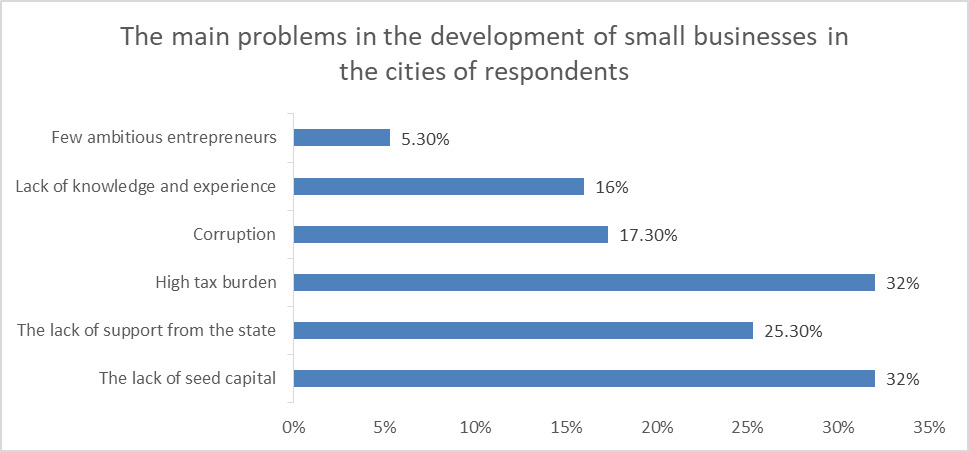
A little more than a third of respondents (37.3%) consider the «Ability to plan» the main quality of small businesses. Slightly more than one quarter (25.3%) indicate leadership qualities and activity; Just over one fifth (22.7%) of respondents believe that Erudition is the qualitiy of small entrepreneurs; 24% of respondents allocate honesty; Frugality and economy chose 14.7% of respondents. (pic.2)
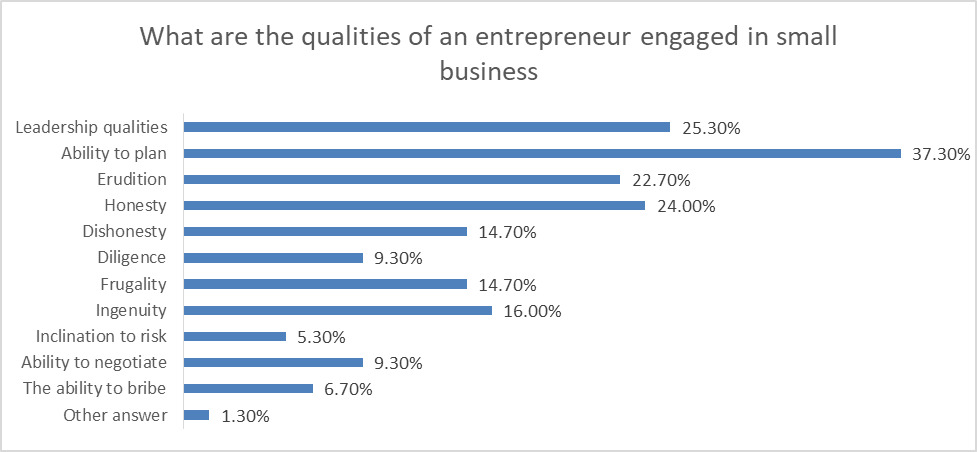
CONCLUSION
In this article the basic concepts and positions of small business were considered and defined, its role in economic, political, social and other spheres of our life is established.
A sociological study was conducted on «Small business through the eyes of young people», which was attended by 75 respondents aged 17 to 35 years. The study provided a portrait of a successful entrepreneur in the eyes of young people and identified some of the challenges faced by entrepreneurs.
Thus, the development of small business leads to saturation of the market with goods and services, better use of local raw materials and it is a reliable source of budget revenues. It follows that the development of small business is necessary for the state.
References
1. Avilova V. V., Bashkirtseva, S. A., Experience of supporting small and medium businesses in developed economies // Vestnik Kazanskogo tekhnologicheskogo universiteta. 2011. No. 10. C. 238—246
2. Yepifanova T.V. Criteria for determining small and medium-sized enterprises // New technologies. 2011. C. 24—32.
3. Mukoseev D. V. Economic essence, the criteria for determining small business // Modern scientific researches and innovations. 2012. C. 15—23.
4. Schastlivaya N. V. Small innovative business in economy of highly developed countries // journal of OSU. 2009. No. 2. C. 48—52.
Motkova V.U.
Payment system «MIR»: history and development
Motkova V.U., 4th year student {Banking}
Scientific adviser: Voevodina I.V., Senior Lecturer
State Budgetary Higher Educational Institution Moscow Region
«University of Technology»
Korolev, Russia
The text considers the National Payment System of Russia «Mir». The article gives the reasons for its occurrence and aspects of using the payment system at the present time. To write the article, the latest data from the official website of the National Payment System, the Central Bank of Russia and Sberbank are used.
Keywords: national payment system, bank, sanctions, Mir.
International payment systems transfer money (money, checks, securities, certificates, conditional payment units) in electronic or real form. The payment system is a set of certain procedures, rules and technical infrastructure for transferring the value of one subject of the economy to another.
Earlier, Russia used payment systems of foreign countries. The largest of them are:
— MasterCard International,
— Visa International,
— JCB Card.
At present, Russia is beginning to switch to its own payment system «Mir». The Mir system was developed after sanctions imposed by the US against Russian banks in 2014, which caused problems with servicing cards by American Visa and MasterCard. And at the end of 2014, Crimea was actually cut off from the international payment market, as Visa and MasterCard completely suspended the maintenance of the maps on the peninsula.
The «Mir» payment system is a Russian national payment system designed to ensure the reliability, security, convenience and accessibility of national payment instruments — «MIR» cards. The operator of the «Mir» payment system is JSC «NSPK» (Joint Stock Company «National System of Payment Cards»). At the time of the creation of the operator, 100% of its shares belonged to the Central Bank of the Russian Federation. And according to the Federal Law of May 1, 2017 N 88-ФЗ — the Bank of Russia share in the authorized capital of the NSPK operator may be reduced, but it can not be lower than 50 percent plus one voting share. The share of each of the other founders (one person or group of persons) should not be more than 5 percent of the shares of the operator of the NSCP, which will not allow to influence the key decisions on the operation of the system, but will further attract investors [1].
The need to develop Mir payment cards was prompted by US sanctions imposed on Russia in the spring of 2014. Due to the sanctions, the world’s two largest payment systems Visa and MasterCard blocked transactions with the cards of Russia’s Rossiya Bank, its subsidiary Sobinbank, and also SMP Bank without any notice on March 21, 2014. Some other banks, in particular, Investcapitalbank, were also confronted with the problems related to payment card servicing. In December 2014, Visa and MasterCard stopped servicing bank cards in Crimea and Sevastopol, later their work was restored.
On May 5, 2014, President Vladimir Putin signed amendments to the Law on the National Payment System and Some Legislative Acts, requiring Visa, MasterCard and other payment systems to switch to processing Russian transactions through the national payment card system (the transition was completed on April 1, 2015). Russia also announced that it would develop a new national payment card.
The Russian national payment system was created on 23 July 2014. In Spring 2015, in the course of an all-Russia creativity competition, the name Mir and the brand logo were chosen.
The Operator of Mir Card Payment System is National Card Payment System Joint-Stock Company.
On December 15, 2015, Russia’s Central Bank and the National Payment Card System announced the commencement of Mir payment card issuance. Gazprombank, MDM Bank, Moscow Industrial Bank, RNCB Bank, Sviaz-Bank and SMP Bank were the first lenders to issue these cards. The mass issuance of Mir payment cards started in the second half of 2016.
The main objectives of the Russian national payment system are:
1) Provision of a reliable money transfer service with the use of national payment instruments;
2) Building of trust to cashless means of payment;
3) Creation of Russian sovereign payments area independent from foreign companies;
4) Issuing of Mir Russian national payment card;
5) Promotion of Mir cards on the international market.
Unlike international payment systems’ card transactions, Russian Mir card transactions cannot be suspended and no external economic and political factors can influence their processing.
Overall, 356 banks or 58% of all Russian credit institutions have joined the Mir payment system by May 2017. Of this number, 75 banks issue Mir cards and 181 lenders accept these cards in their payment terminals.
Last year, as part of its integration into the Mir system, Sberbank began servicing Mir cards at cash machines, retail and service points. The bank said there are approximately 1.2 million POS terminals that accept Mir cards at 800 retail and service locations, as well as 24,000 online stores throughout Russia.
NSPK is ready to conquer the 230 million-card Russian market, and according to Central Bank Governor Elvira Nabiullina, 90 percent of ATMs in Russia are ready to accept the new payment system [2].
According to the bank, «public sector workers, pensioners, and other clients, who chose Mir for their personal needs,» are among the cardholders.
An important point in the operation of the payment system is the safety of the cards issued. To this end, in 2015, NSCP passed the procedure for assessing compliance with the requirements of the International Card Security Data Security Standard (PCI DSS 3.1) and received a certificate of compliance.
It is also important that on the «Mir» payment card, thanks to the established national operationally independent platform, processing of domestic transactions is performed only in Russia. And earlier, before the creation of the NSPK, information on any transactions of citizens of the Russian Federation with the help of MPS cards was sent for processing to processing centers located abroad, which is not safe today [3].
The number of «Mir» cards starts with the number 2, which indicates that the card belongs to the Russian national payment system «Mir».
The head of NSPK Vladimir Komlev said the cards could soon be used across Europe and the international acceptance of Mir shows the system’s maturity. Agreements have been signed with MasterCard, JCB, AMEX and the Union Pay payment systems, he said, adding Mir cards will soon be accepted by online payment platform Alipay, and there are plans to connect to eBay [2].
In addition, the promotion of Russia’s national cards abroad begins, first of all, with cooperation with national payment systems of the countries of the Eurasian Economic Union, namely:
— «BELKART» -Byelorussia
— Armenian Card (ArCa) — Armenia.
Thus, the agreement on cooperation between the national payment systems of Russia and Armenia was signed in June 2016, and in August 2017 a pilot project on the integration of national payment systems was completed.
In July 2017, the first transactions on Mir cards in the infrastructure of the ArCa payment system were successfully completed. The settlement bank of the national payment system «Mir» in the course of transactions between two payment systems is VTB Bank. All settlements are made in the national currencies of the Russian Federation and the Republic of Armenia.
In Russia, the first virtual map of the PS Mir has already appeared, which was launched by the Bank RUSSIA on November 21, 2016. It should be noted that under the sanctions of the West, «Bank RUSSIA» is in the forefront of developing and launching banking products created on the basis of «Mir» payment cards.
References
1. Ivanov, V. Dengi, credit, banks: a textbook and a workshop for academic bachelor’s degree / VV Ivanov, BI Sokolov; Ed. VV Ivanova, BI Sokolova. — M.: Publishing House Yurayt, 2017. — 371 p. — (Series: Bachelor, Academic Course). — ISBN 978-5-534-01182-1.
2. Official website of the NSPK: http://www.nspk.ru/cards-mir/
3. Official website of the «Mir» payment card: http://mironline.ru/
4. Official website of the Central Bank: https://www.cbr.ru/
5. Official website of Sberbank: https://online.sberbank.ru/
Mustafina L.L.
The impact of social policy on the process of demographic reproduction in Russia
Mustafina L.L, 3rd year student {Sociology}
Scientific adviser: Kyuregyan M.P., Senior Lecturer
State Budgetary Higher Educational Institution Moscow Region
«University of Technology»
Korolev, Russia
In this article, on the basis of statistical data the study of the demographic situation in Russia. Special attention was given to moral and value orientations of the respondents, their attitude towards the country’s demographic situation.
Keywords: demography, politics, population, reproduction.
The demographic situation plays an important role in the economic, social and political development of the country. The solution of certain strategic tasks in various areas of human activity is possible only at a certain numerical level and qualitative composition of the country’s population. The severity and unsolvedness of demographic problems determines the essence of state issues.
In Russia in the beginning at the 2000, the Government adopted important legislative acts aimed at increasing the population by providing material support, which had a favorable outcome: in the country the natural increase in the population actually increased [2, P.36]. The demographic crisis of the country, we can assume, has declined, however, the demographic situation in Russia is still unstable.
In the study of the expert of the Center for Scientific Political Thought and Ideology, Candidate of Sociological Sciences, Nadezhda Khvylya-Olinter, data have been revealed that the decline in fertility is not associated with a deterioration in material well-being [3, P.15—23]. And moreover, the Soviet psychologist V.V. Boyko [1, P.98—99] also wrote that the material factor can act on the reproductive behavior of a person inversely proportional.
In connection with this problem, the question arose: what conditions are necessary to stabilize the demographic situation in the country?
The goal was to analyze the impact of state social policy on the process of population demographic reproduction in Russia.
Demographic behavior in society depends both on the social and material conditions of life, and on existing norms and values in a particular society. Therefore, it is necessary to study the dominant attitudes of the population, its ideology regarding the demographic state of the country.
The following research tasks were put forward:
1. Identify the values of the respondents.
2. Determine the factors that influence the decision on the birth of a child.
3. Analyze the opinions of respondents on how to increase the birth rate in Russian families.
An empirical sociological study on the topic: «The attitude of Russians to the demographic situation in the country» was carried out be the method of questionnaire survey.
In this study, residents of Moscow suburbs of different age categories from 17 to 32 years old took part. Most of them are young people under the age of 20 (see Figure 1), including 35% of men and 65% of women.
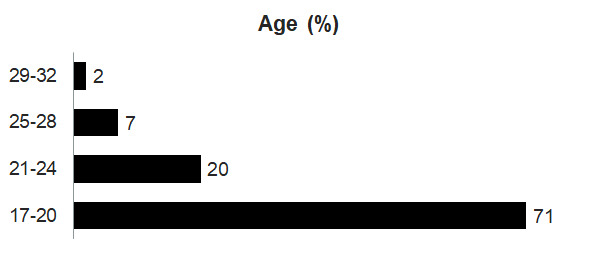
Respondents identified the «family» as the greatest life value, about the same number called «friends.» Friendship with peers for young people is significant since adolescence, most of them do not yet have their own family. However, respondents already realize that children in their future family are also of great value, as well as health. Such a vital value as «serving people» was in the last place (see Figure 3).
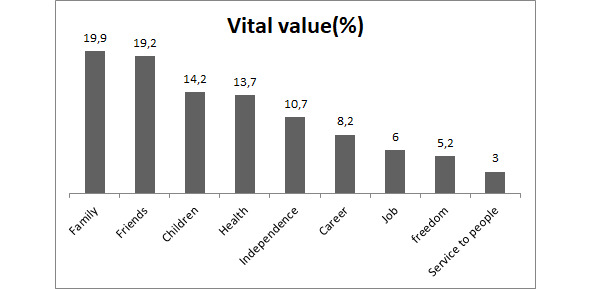
About 60% of respondents noted that their decision to have a child will be most influenced by the existing «family relations». They note such material factors as the availability of housing and the level of wages, because most of them depend financially on their parents. It should be noted that the importance of the «health» factor for the birth of children is realized only by 40% of respondents, young people, as a rule, do not think much about it (see Figure 3).
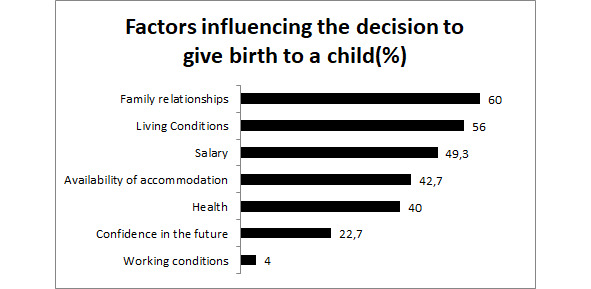
In the hierarchy of measures taken to increase the birth rate, respondents put on the first place material support for families with children, then — «improving living conditions.» This again indicates the insolvency of the majority of respondents in the material plan, so such measures are relevant for them. Respondents consider it necessary to revive and support traditional family values (14%), realizing the danger of spreading liberal ideas aimed at weakening family institutions. «Expanding the list of privileges for families with many children» in the fourth place. Increasing the level of medical care and the environmental state of the environment are in the last place (see Figure 4).
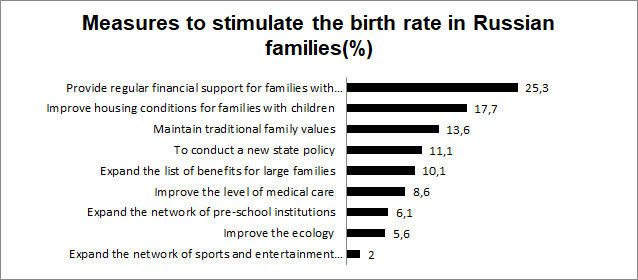
The analysis of the data obtained in the course of the empirical research allows us to draw the following conclusions. The most significant value for young people is traditionally: family, friendship, children, health. However, they put such value as «serving people» in the last place, which affects the demographic situation in the country. Factors influencing the decision on the birth of a child were identified. «The existing relationships in the family» respondents consider the most significant factor. Further, such material factors as «conditions for life», «wages», «availability of housing» and a factor with political overtones — «confidence in the future» were highlighted.
The work done revealed the opinions of the respondents on a number of topical issues of the moral, ethical and material and practical plan.
To stabilize and further effectively develop the demographic situation in Russia, the following is necessary:
● Strengthen the institution of the family, revive and preserve spiritual and moral traditions and family values.
● Provide material support to families with children and expand the list of benefits for large families.
The study of this problem should be continued to develop more specific and valid recommendations for solving the problem of demographic reproduction in the country.
References
1. Boyko V.V. Fertility: Socio-psychological aspects. M., 1985. — P. 98—99.
2. Putin’s plan: a dictionary of political terms / comp. A. Chadayev, K. Loginov. — M.: Europe, 2007. — P. 36, 144 p.
3. Khvilya-Olinter N.A. Demographic state of modern Russia // Social life and power. — 2015. — No. 4 (54). — P. 15—23.
Nikolaeva A.S.
World festival of youth and students: history, development and its impact on the world youth movement
Nikolaeva A.S., 3rd year student {State and municipal management}
Scientific adviser: Voevodina I.V., Senior Lecturer
State Budgetary Higher Educational Institution Moscow Region
«University of Technology»
Korolev, Russia
The article considers the current tendencies in the world youth movement for peace and democracy. The author pays special attention to the history and the origin of the World Festival of Youth and Students. The significance of this event and its impact on the social, political and cultural life of young people in different countries of the world is analyzed. Working as a volunteer at the Festival 2017 in Sochi the author gained valuable experience of communicating with young people of different cultures and different ways of life. Personal impressions are described in the article and arguments in favor of holding such festivals in future are given.
Keywords: youth movement, international cooperation, personal experience.
The year 2017 marks the 70-th anniversary of the World Federation of Democratic Youth. The first Festival of Youth and Students took place seventy years ago in Prague. Its central ideas had already taken shape then: the struggle for peace and young people rights, antifascism, internationalism. Today the festival’s motto is: «For peace, solidarity, and social justice we fight against imperialism — «Honoring our past we build the future!» [1]
The history of Russia includes two World Festivals of Youth and Students. Both were held in Moscow in 1957 and in 1985. The 1957 Festival was an event of the post-Stalin thaw that gave Soviet people the idea of other cultures and other ways of life. It demonstrated that the Soviet Union was not afraid of hosting guests from other countries and that it is ready to have friends. The sixth festival became the most large-scale in the history. It has brought together 34 thousand participants from 131 states and has left a mark on student’s culture. Interest to foreigners was huge. The streets of Moscow were crowded with those wanting to speak to the members of foreign delegations and discuss different problems with them. After the festival the Soviet youth joined fashion for a rock’n’roll, jeans and foreign names. «Iron Curtain» was punched [2].
The 1985 festival in Moscow was no less memorable. It can rightly be called historic, as it allowed the Soviet citizens to discover a new world in music, art and literature, and share their achievements with young people from abroad. It was the opportunity to establish friendly relations with them.
In 2017, Russia again had the unique opportunity to hold this grand festival. From October 14 to October 22 Russia hosted the 19th World Festival of Youth and Students. The main venue of the festival was the Sochi Olympic Park. Besides this a colorful carnival took place in Moscow. It was held from the Kremlin to the stadium «Luzhniki». The unusual feature of the World Festival of Youth and Students is that it spread throughout the country. Two thousand foreign participants visited fifteen regions of Russia from Vladivostok to Kaliningrad [3].
As in previous years, the symbol of the festival was a multi-colored daisy, symbolizing the continuity of traditions, the link between generations, peace and unity of the entire world community. However, this time the main element has become colored pixels as a sign of commonality of the world’s youth in the age of information and technological progress. The diversity of views and opinions are the main characteristics of the XIX world festival of youth and students [4].
Festival of youth and students is an amazing event, a global event in which I managed to take part and witness very many interesting things that I will never forget.
When the registration for the festival began, I immediately decided that I wanted to work as a volunteer. I had a great desire to be in the center of this event, help with the preparation and the organization of the festival and see everything with my own eyes. My involvement and assistance in the organization of the festival meant very much to me. I wanted to invest part of myself in this significant for Russia event.
A record number of volunteers participated in organizing the festival. Our team of 5 thousand young people included the representatives of 67 countries of the world. The «silver volunteers», that is, people older than 55 years, also assisted the organization of the event. The oldest volunteer was 85 years old. For the first time in the history of the festival, United Nations volunteers attended the organization of events.
Volunteers were constantly present at all the events of the WFYS discussing possible platforms for events, helping to settle problems. And if it required they were always ready to provide first aid and to improve the mood of the participants. To thank them the organizers of the forum launched the campaign «Hug a volunteer», which was popular among the participants.
My task was to organize the work at the so called «Ice cube». Various theatrical performances, musicals, castings took place on this platform. My duties included: welcoming guests, proper distribution of people in the hall, monitoring of compliance with the order. While carrying out our duties we could also watch the performances together with those present. I was greatly impressed by the performances produced by the Moscow Poets Theater and «The Moscow Ballet» theatre.
When our delegation of volunteers arrived at the WFYS we were ready to face different conflicts and settle the problems. However, despite the fact that the festival brought together people of different nationalities, beliefs and political views, friendly atmosphere reigned and the atmosphere of mutual understanding prevailed. Every day we met people from all parts of the world, communicated and learned a lot of new and interesting information about other countries, their traditions.
The program of the festival was very diverse and provided a huge choice for every taste. In accordance with tradition, each day of the festival was dedicated to this or that region of the world: America, Africa, Middle East, Asia and Oceania and Europe. The day of Russia took place on the 21-st of October, a great number of people attended this event.
World Festival of Youth and Students is a platform for dialogue, for global communication: through discussions, cultural programs, sports, through free communication it gives opportunity to find ways to confront the challenges that younger generation is facing today.
The discussion program of the XIX International festival of youth and students in the Main media center was very popular. Speakers at the discussion were such famous persons as Sergey Lavrov, German Gref, Vyacheslav Volodin, Vladimir Zhirinovsky, Maria Zakharova, Nick Vujicic, Marko Lambertini, Doron Avni, Frederic Beigbeder, Sergey Bezrukov and many others. The youth showed enormous interest in the educational program of the forum, all the platforms were attended by the representatives of all delegations. Everybody was eager to ask questions and to discuss difficult problems with the speakers [5].
The new international youth exhibition brand YOUTH EXPO was launched and worldwide promoted at WFYS 2017. All visitors to the Main Media Centre were able to learn more about the national peculiarities of Russia’s regions and foreign countries, promising youth projects, and achievements in science and culture [6].
In addition to the scientific and educational programs at the festival cultural and sports programs were held. In the context of cultural programs it was possible to visit the World youth film forum area where the best films were shown. Festival guests could take part in such an interesting event as the «Battle of robots». This is the international level championship in sport battles of robots. Developers control their devices with the help of radio. Robots of various configurations compete with each other in the arena using different weapons, changing appearance and modes of movement.
In the context of sport programs, it was possible to visit open sport dance classes, take part in football matches, visit martial art masterclasses, skate and enjoy unforgettable emotions. Walking in the Olympic Park, the festival participants had a chance to ride a new smart bike that worked with a special application [7].
A huge number of events embraced the festival and at times, it was difficult to choose just one thing. It was an unforgettable opportunity to visit cultural, sports and educational events. The organizers took care of the comprehensive development of the participants and gave everyone the opportunity to test their skills in different spheres.
Together with other volunteers I had a unique possibility to watch the work of the festival from inside and see how difficult it was sometimes to overcome problems. But now it all seems insignificant. When participants approached us and thanked for our assistance we realized that we succeeded in our work and we all felt proud.
References
1. Official website WFYS 2017 [Electronic resource]. — URL: http://russia2017.com/.
2. Foundation «Russkiy mir» [Electronic resource]. — URL: https://www.russkiymir.ru/en/publications/231730/
3. Events of the year [Electronic resource]. — URL: http://yaa2017.com/events/festival-molodezhi-i-studentov-2017/.
4. City portal of Sochi [Electronic resource]. — URL: https://city-sochi.ru/meghdunarodnyy-festivaly-molodeghi-i-studentov-sochi-2017.html
5. Festivals 2017 [Electronic resource]. — URL: https://allfest.ru/news/wfys2017-programma
6. TASS Rassian news agency [Electronic resource]. — URL: http://tass.ru/wfys2017/about/
7. News 2017 [Electronic resource]. — URL: http://god2018.su/festival-molodezhi-i-studentov-v-2017-godu/
Pavlova A.V.
The magic of Russian ballet
Pavlova A.V., 2nd year student {Sociology}
Scientific adviser: Kyuregyan M.P., Senior Lecturer
State Budgetary Higher Educational Institution Moscow Region
«University of Technology»
Korolev, Russia
This article reveals the theme of Russian ballet. Dance allows creating special atmosphere, rhythm of talking, moreover, it can be as a language of communication. The ballet was born between the 14 and the 16 centuries in Italy. But Russian first ballet school of choreography was opened in the 18 century.
Keywords: Ballet, choreography education, dancing schools.
In Russia 2018 was announced as a year of ballet. The fact is this year not only Russian people celebrate the 200th anniversary of Marius Petipa who was a famous choreographer and has made meaningful contribution to the development of Russian ballet. In spite of this fact that he was from France but lived for a long time in Russia. His working is very valuable for our country today too [7].
An increasing interest to ballet does not surprise anymore. The ballet gives best opportunities to realization in poetical image. It is not inferior in power of emotional appeal to another art form.
There are many statements about emergence of dancing. One of such is that ancient hunters emulating animal movements believed that subject visualization affected itself and dancing would lead to successful hunting. Many years later the hunting life style created working dances characterizing links between artistic and production activities, for instance, dancing of New Zealanders representing boat carving.
Nowadays dance allows creating special atmosphere, rhythm of talking, moreover, it can be as a language of communication. You can show your mood and also tell your own story using dancing and vast of decorations and dresses [4, с. 6—7].
The modern word «ballet’ comes from a Latin term «ballo’ meaning «I’m dancing’.
In contrast to dance the ballet is so young. It was born between the 14th and the 16th centuries in Italy but earlier than opera. In the beginning it was a little dancing performance presented at carnivals and another holidays. But it had become a heritage of aristocracy during transforming ballet to an independent theatrical genre. Dances of characters in costumes were a part of the palace celebrations. Such performances turned into great spectacles in the 16th century.
Passion of dancing spectacles spread to other countries, including Russia with its first ballet school of choreography opened in the 18th century [6, С. 3—7].
Бесплатный фрагмент закончился.
Купите книгу, чтобы продолжить чтение.